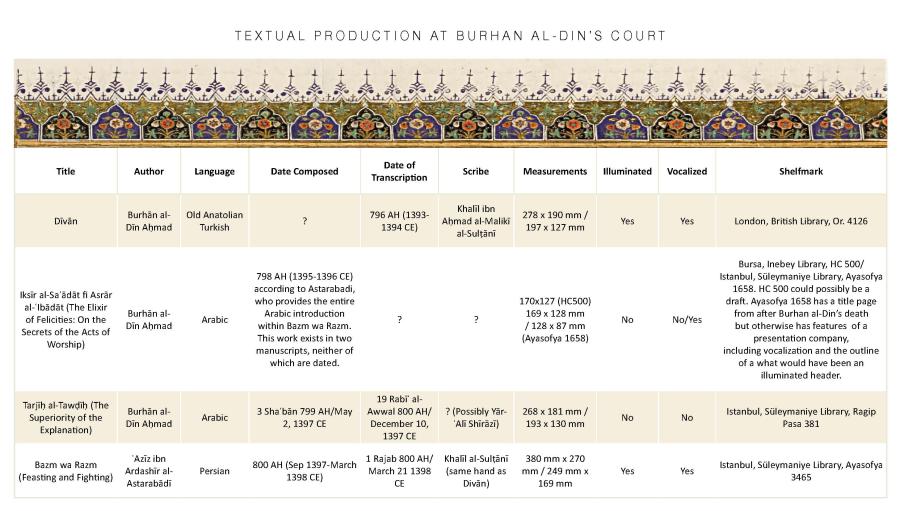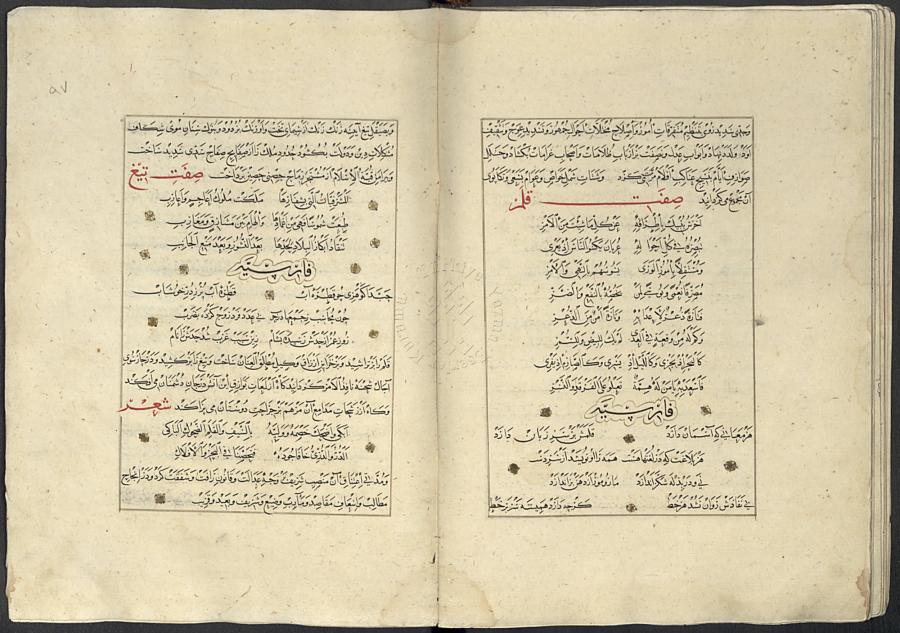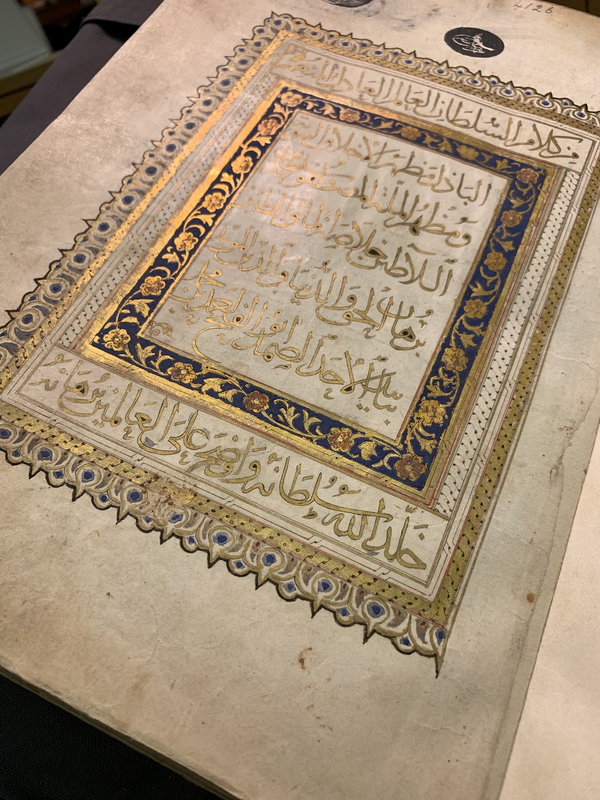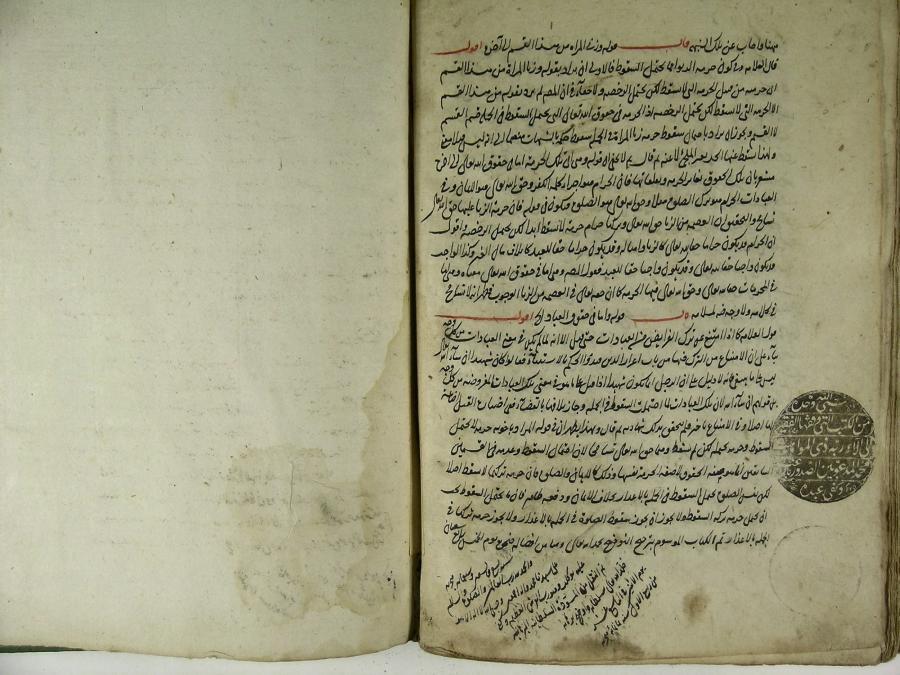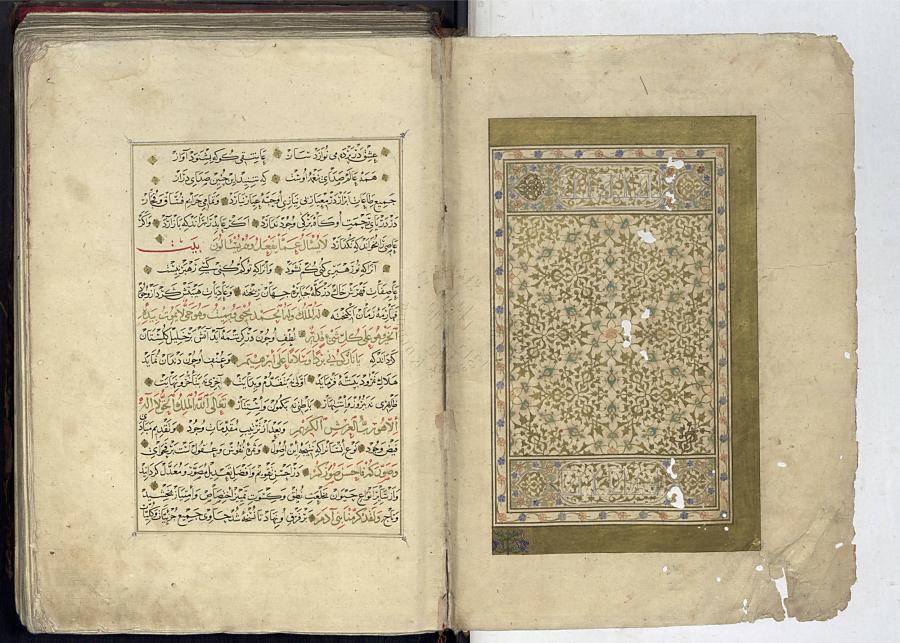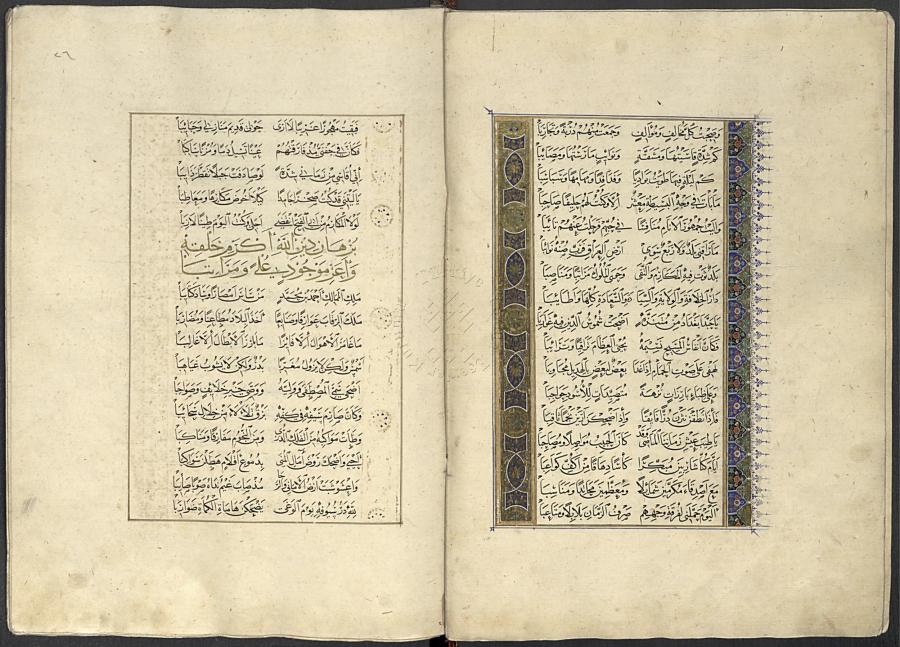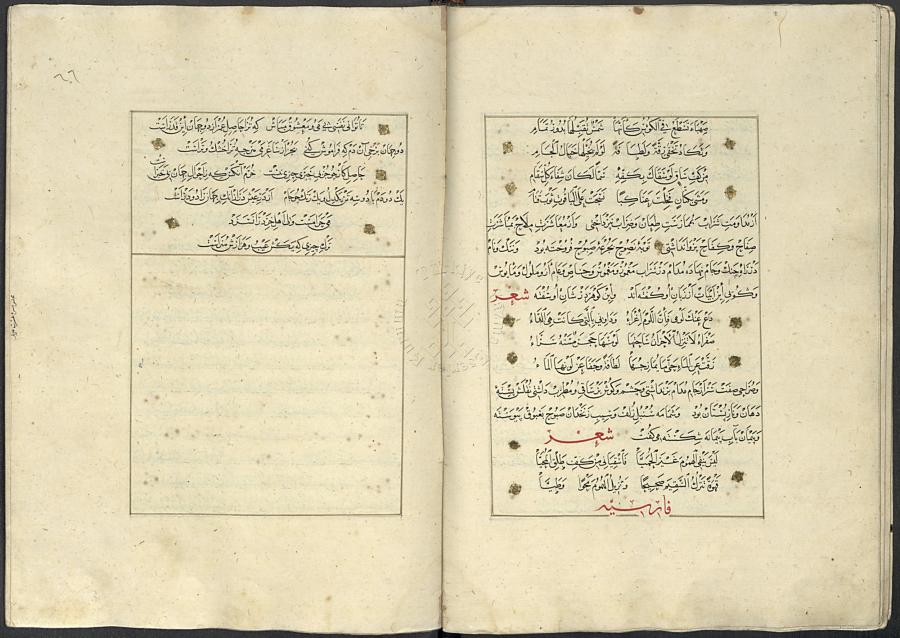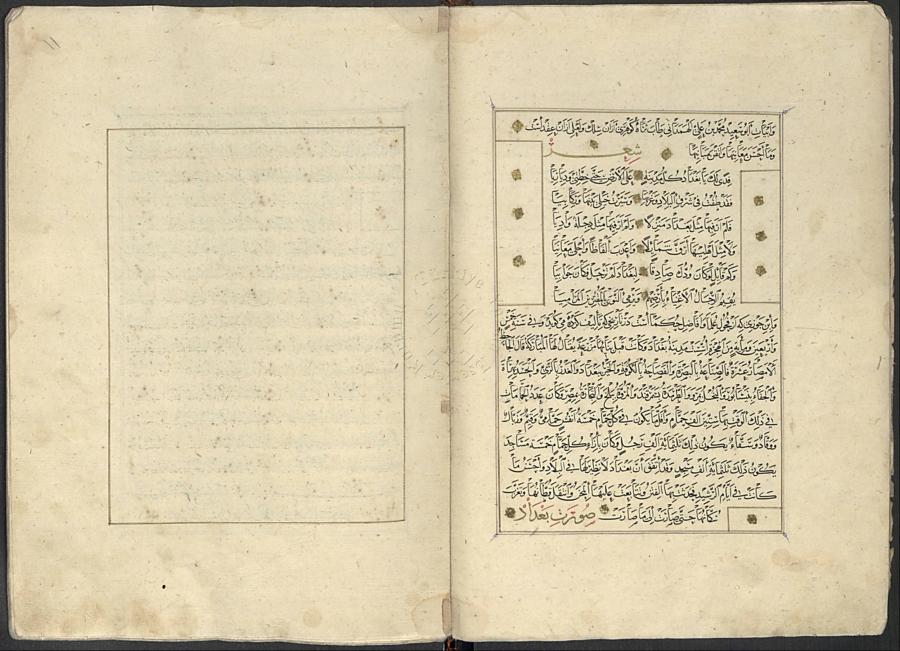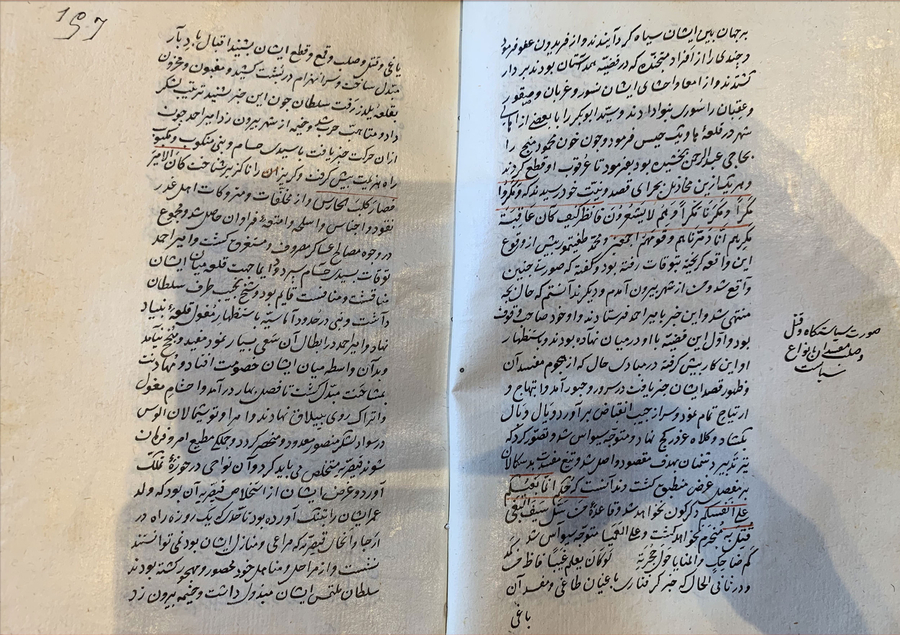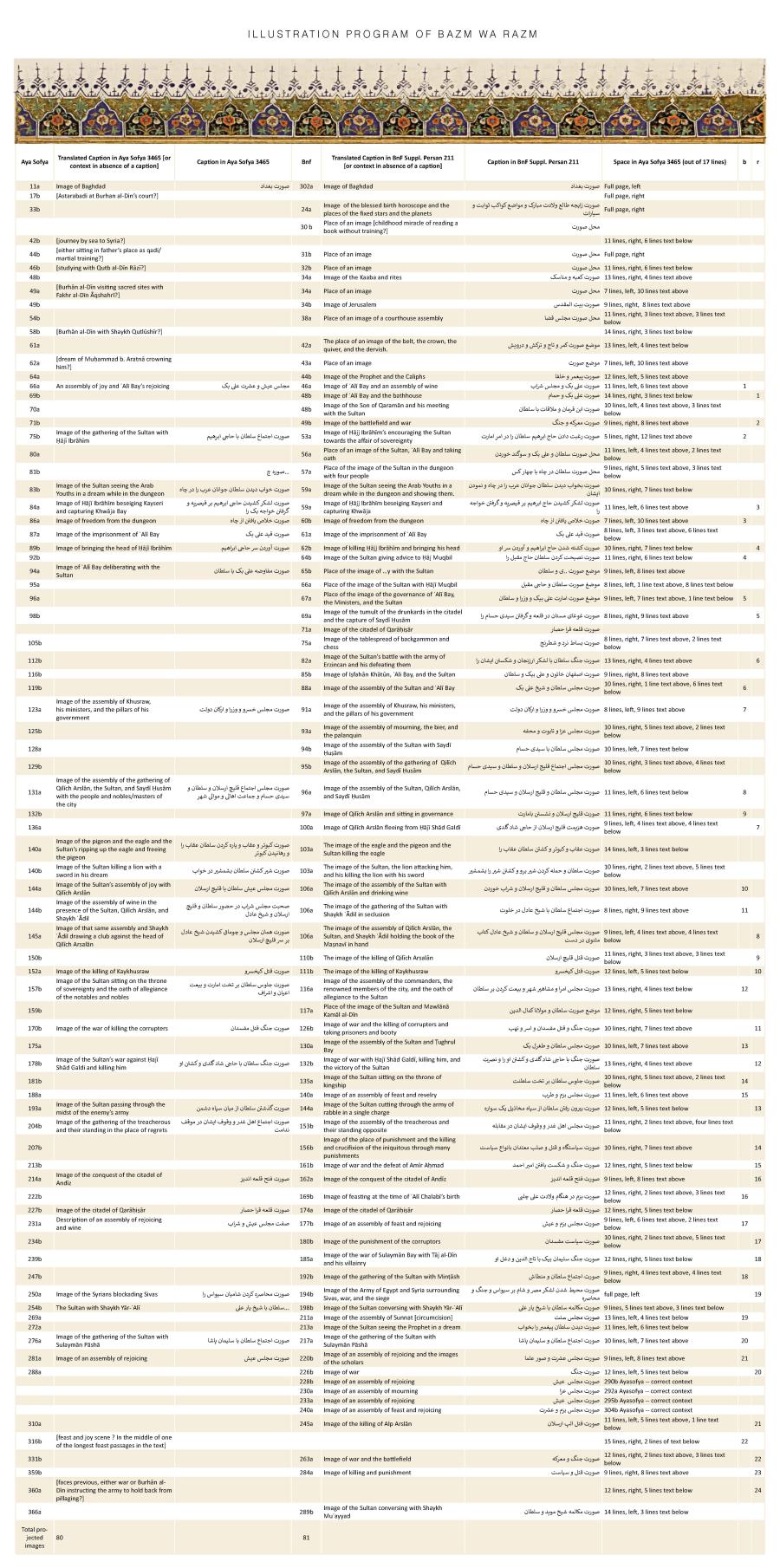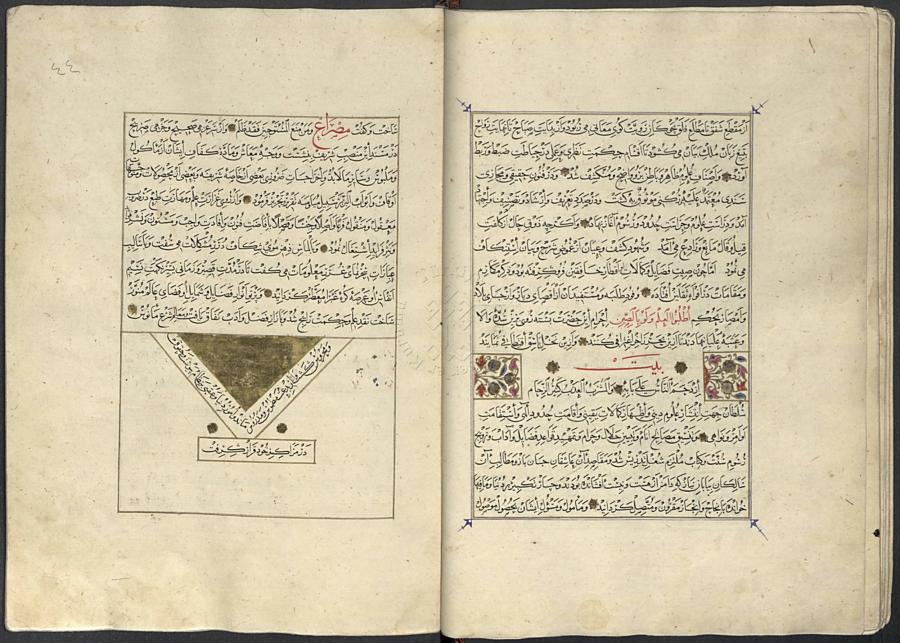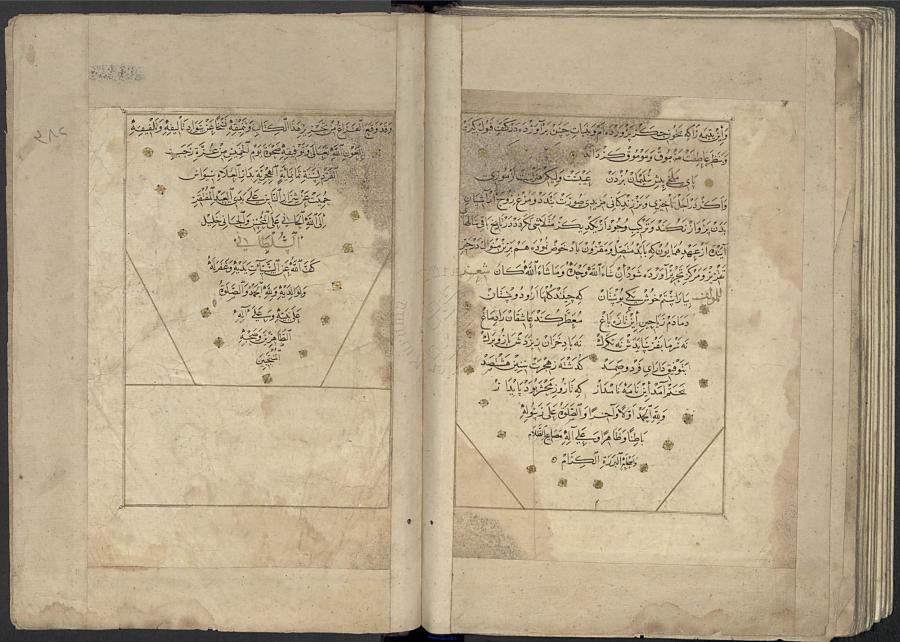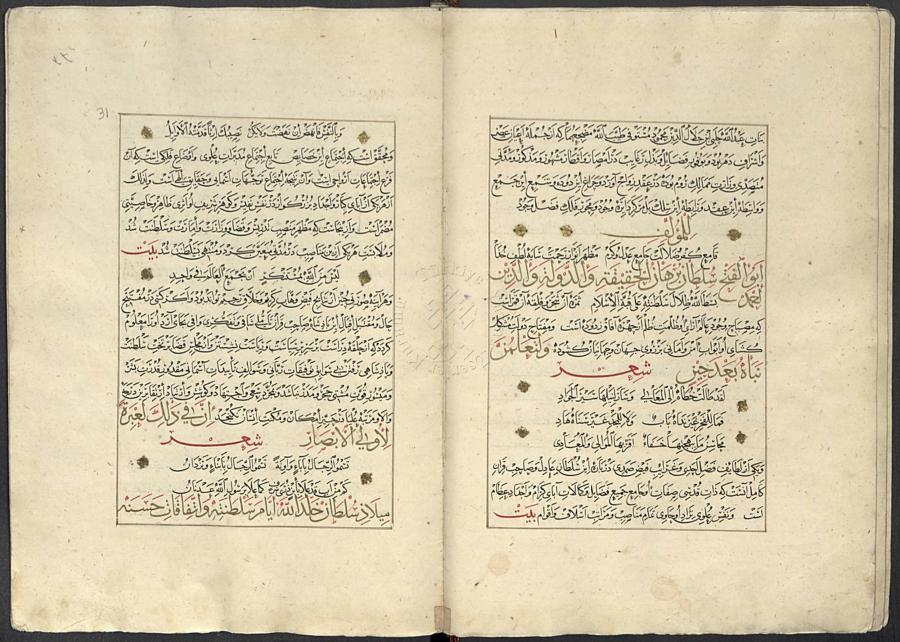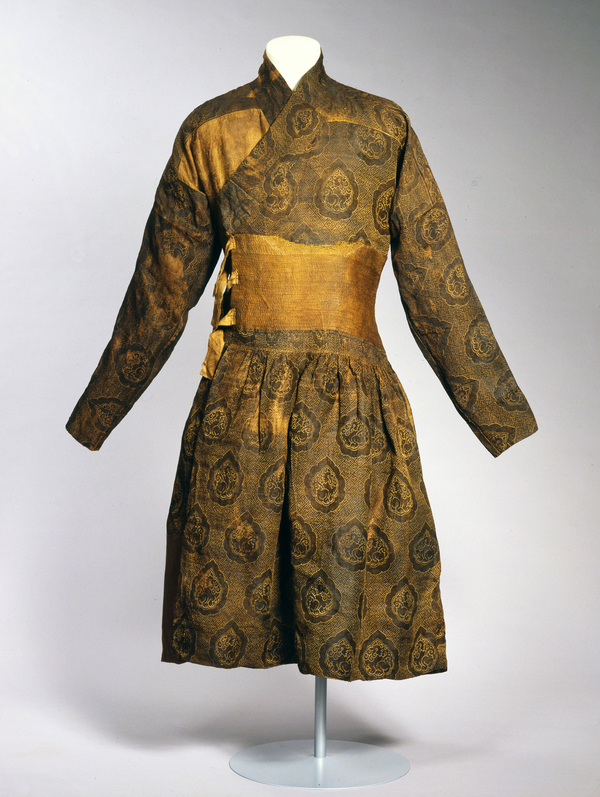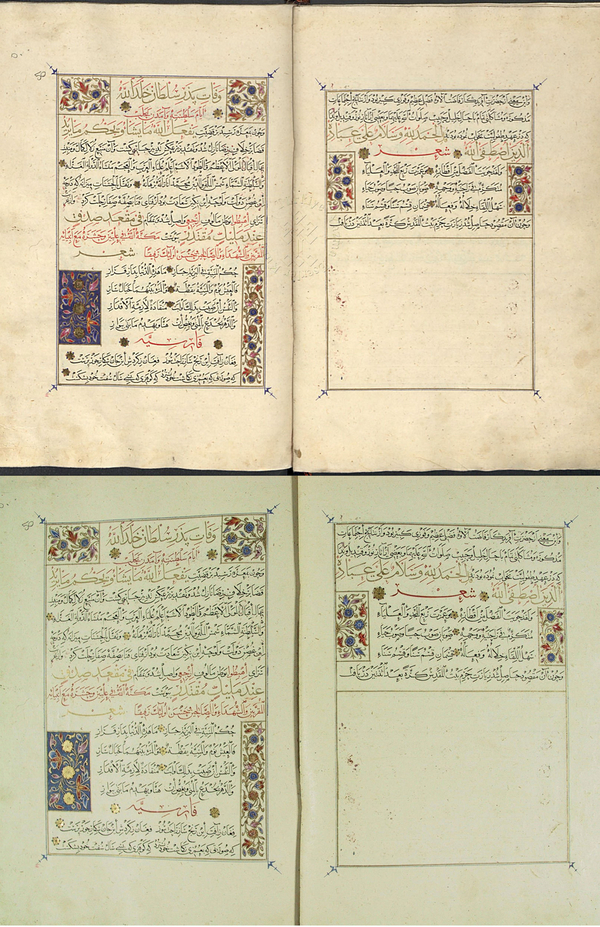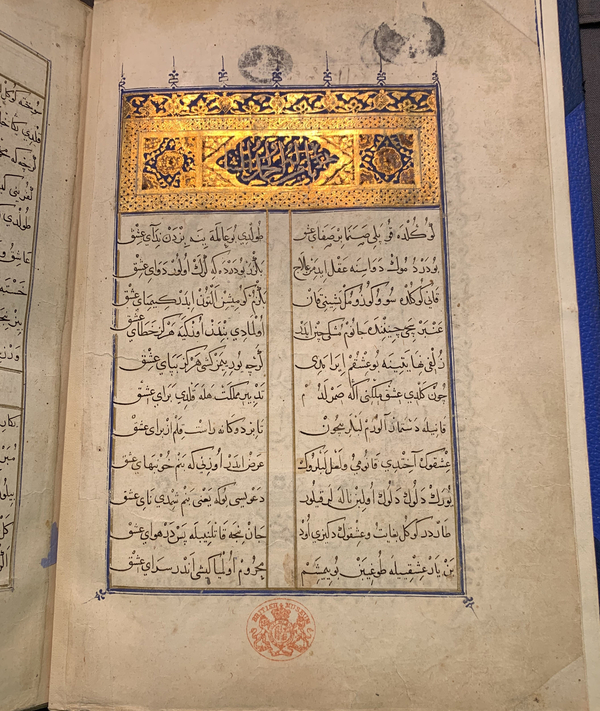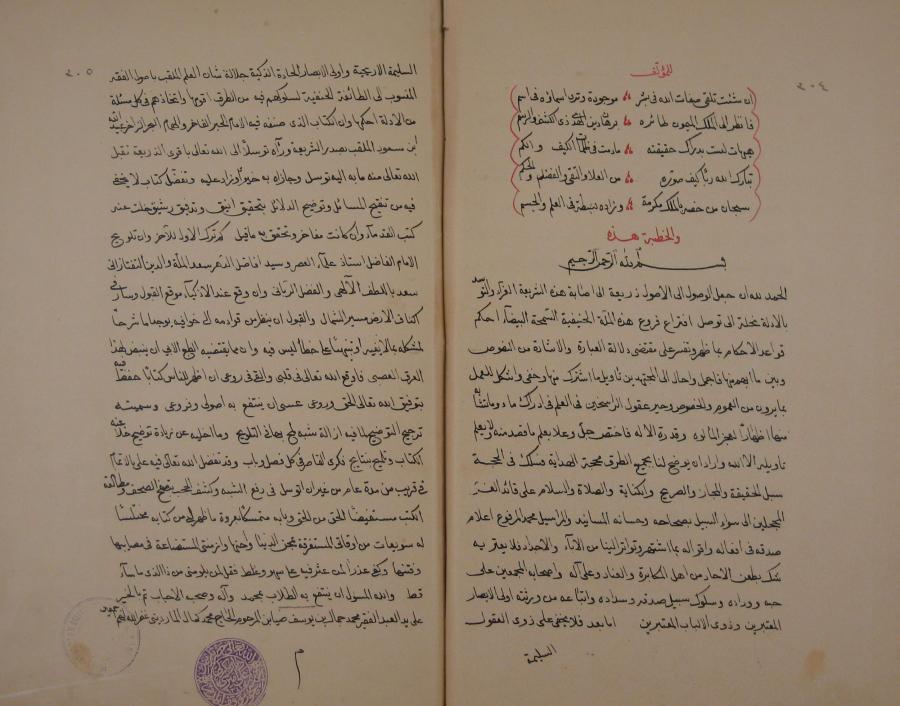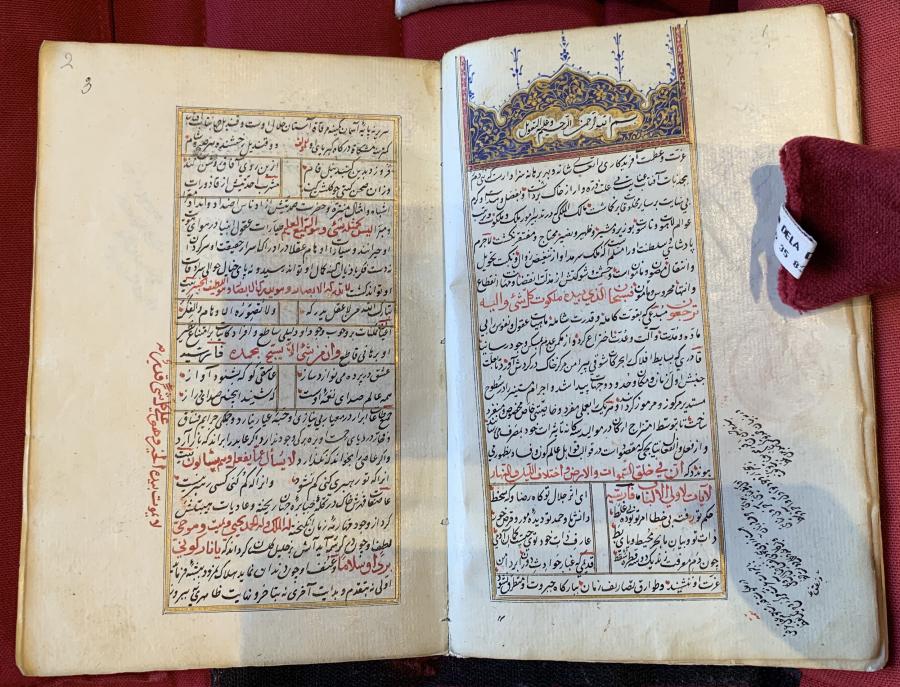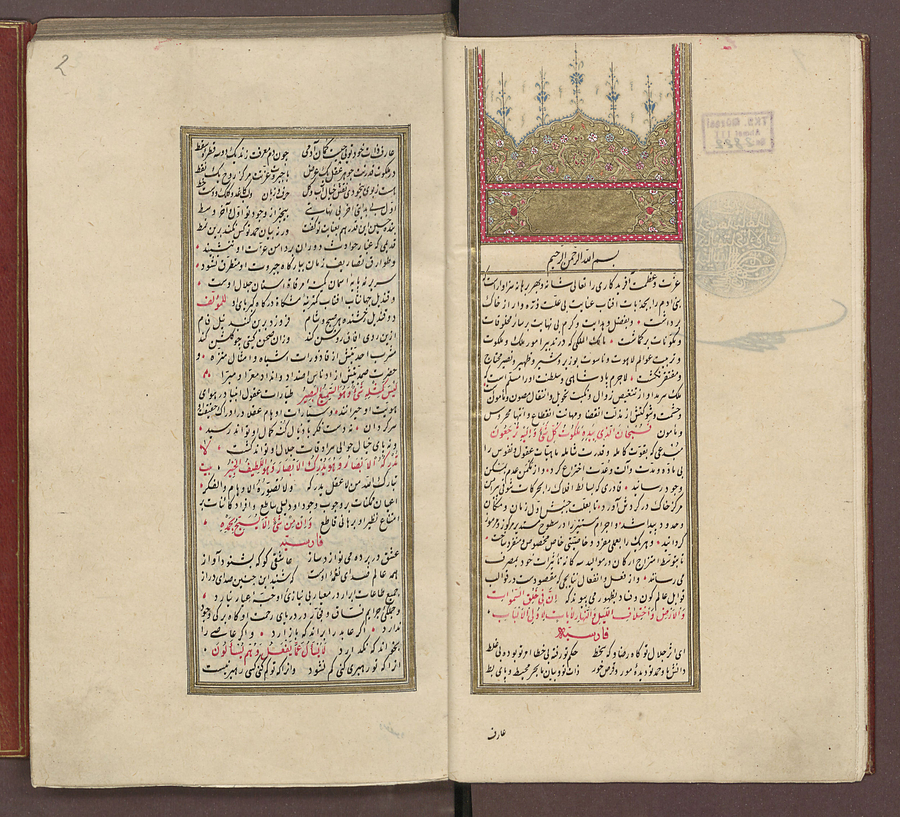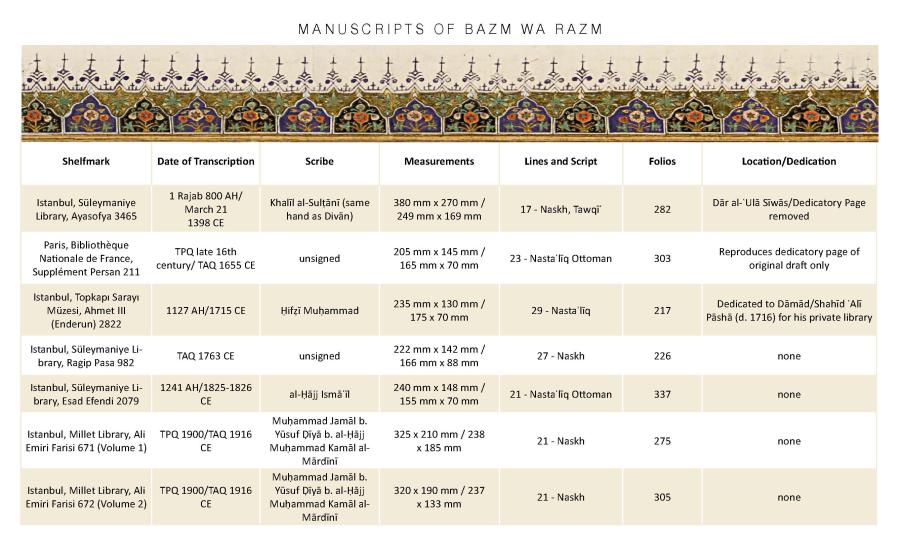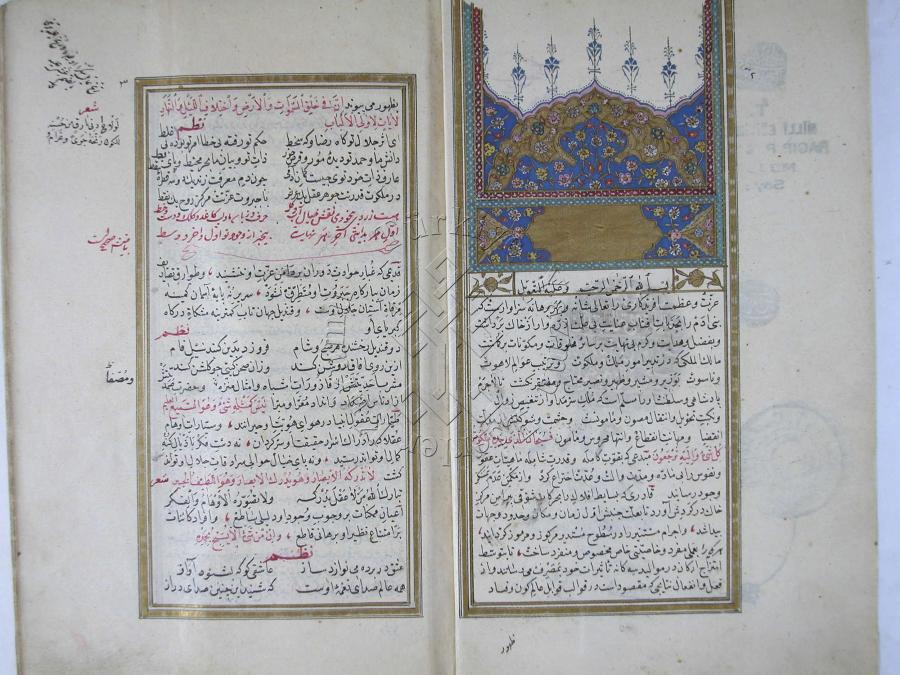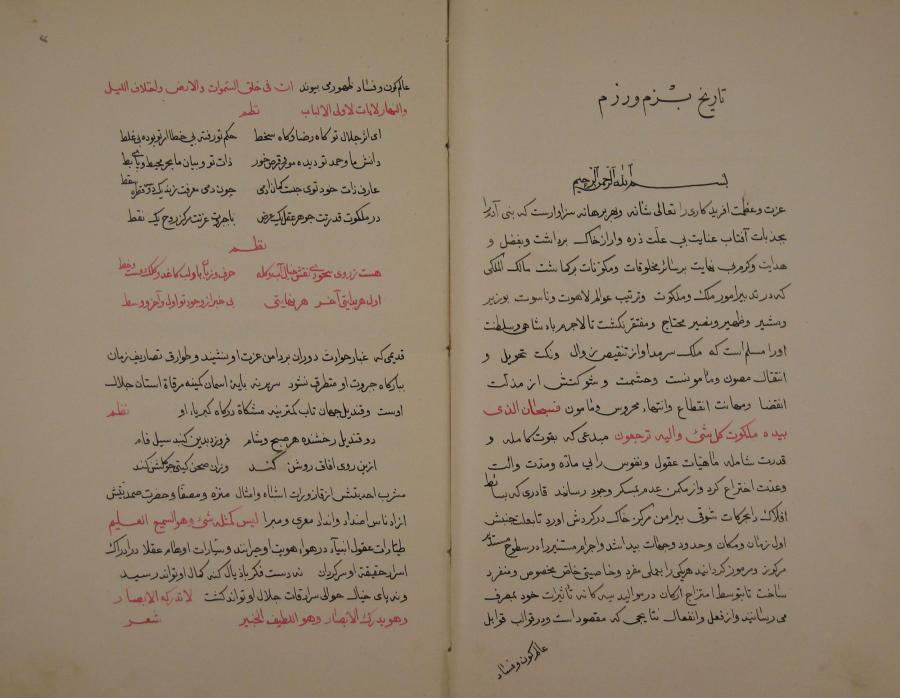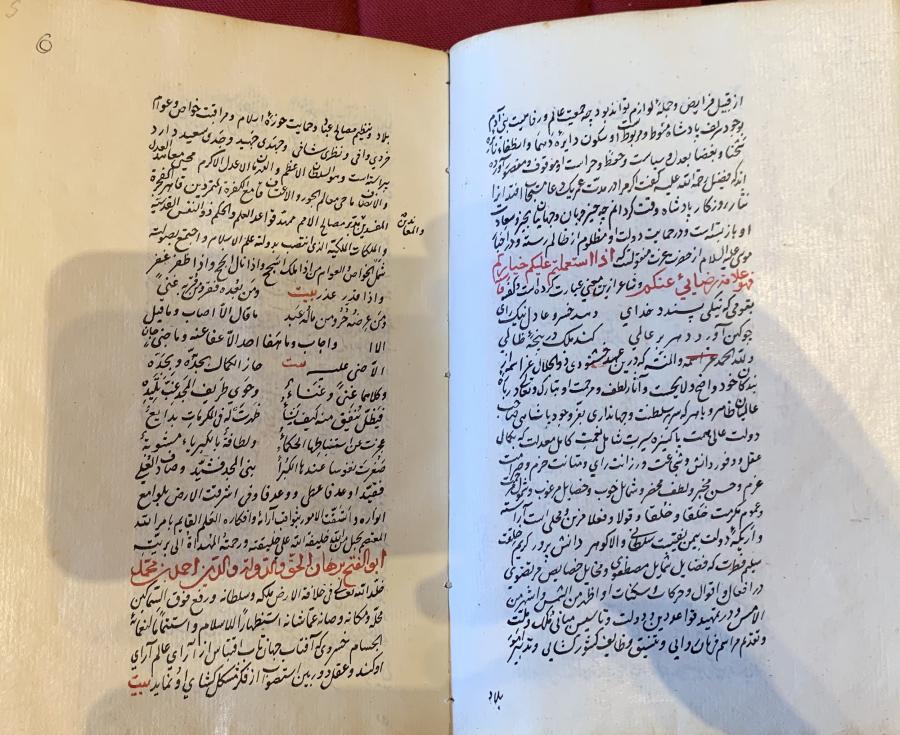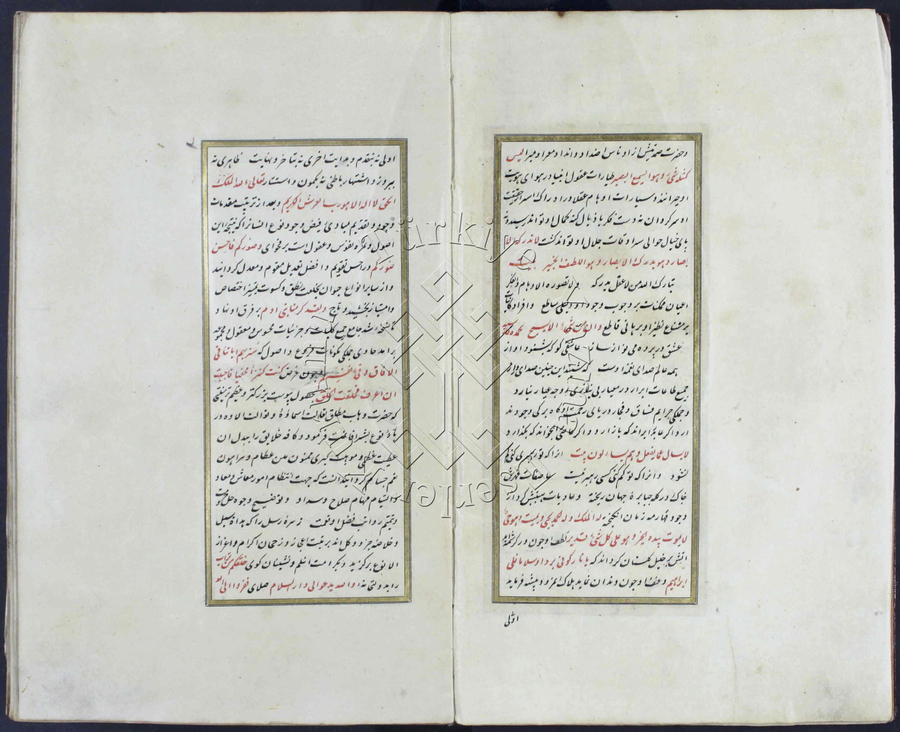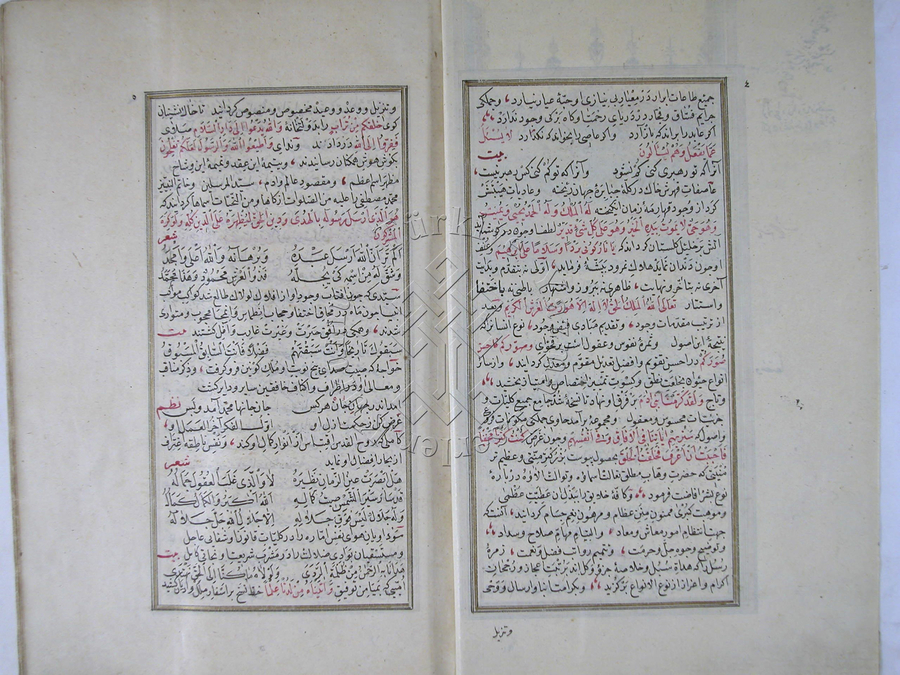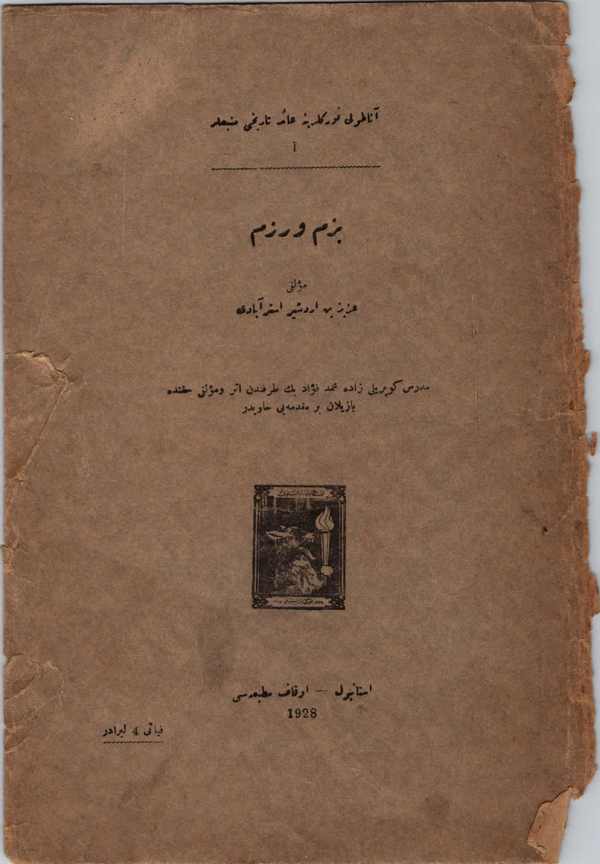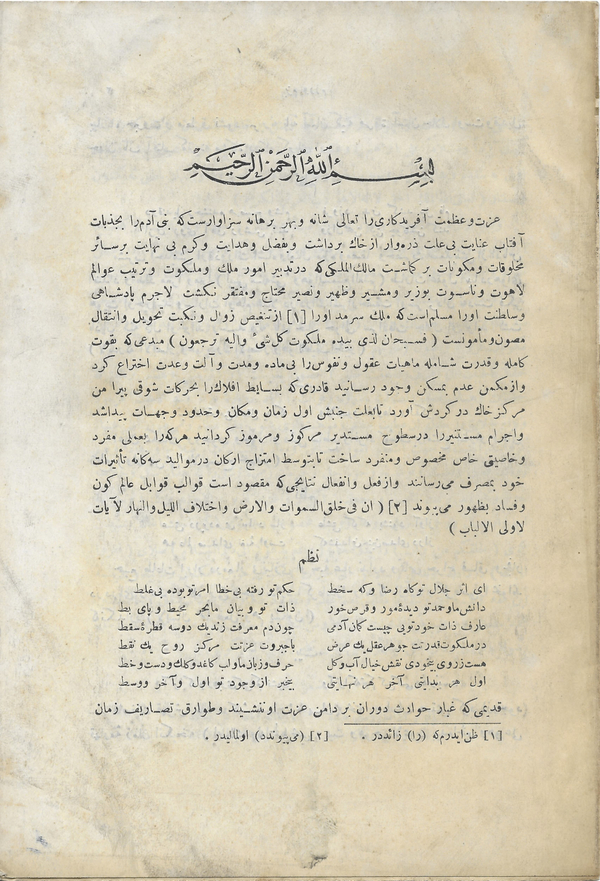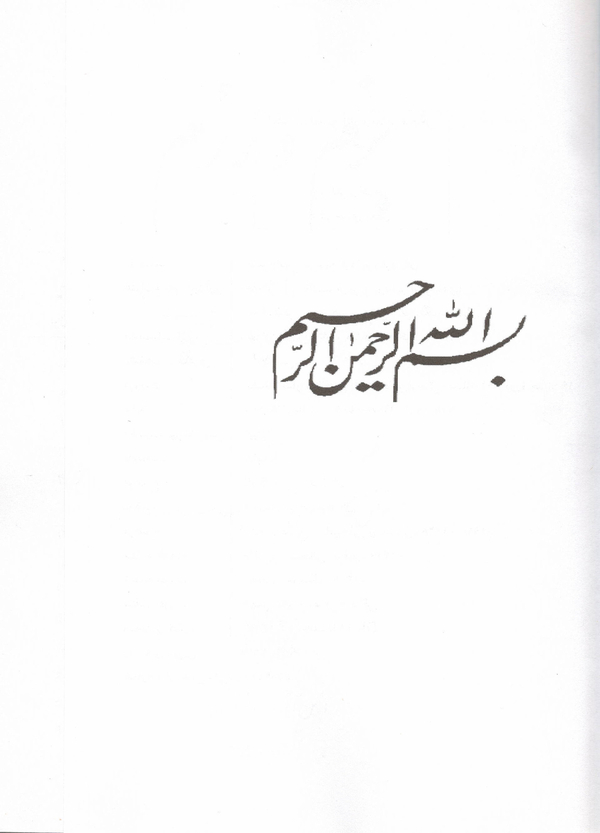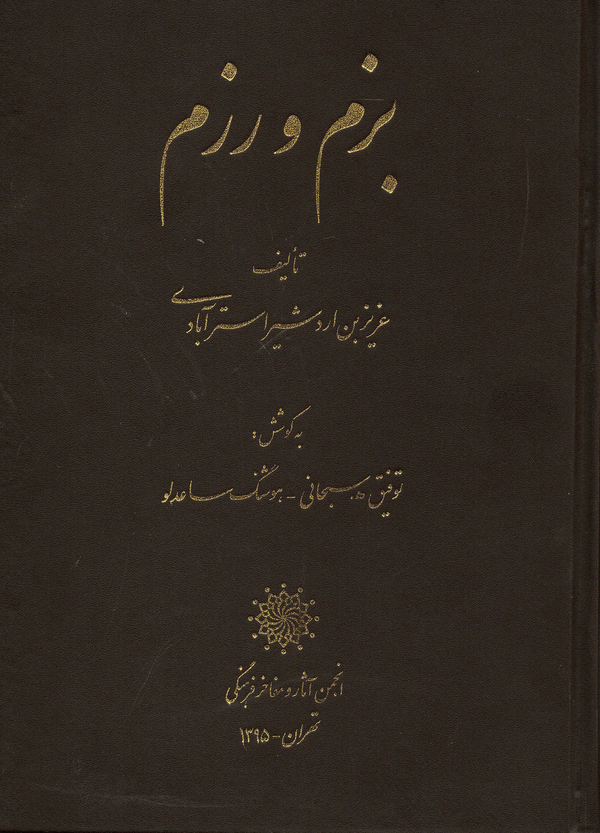Ali Karjoo-Ravary is the Richard W. Bulliet Assistant Professor of Islamic History at Columbia University. He received his PhD from the University of Pennsylvania in Islamic Studies and was previously the Josephine Hildreth Detmer and Zareen Taj Mirza Assistant Professor of Islamic Studies at Bucknell University. He works on the intellectual, social, and material history of Islam.
I’ve adorned a garden of delight
from which friends can pick flowers
whose fresh blossoms, with every breath,
perfume the lovers’ senses.
Neither freeze nor hail will cause it to wilt;
nor the winds of autumn bring its leaves to fall.
With this poem, the fourteenth-century historiographer ʿAzīz ibn Ardashīr al-Astarābādī concluded a nearly eight-hundred-page history of his patron’s reign.1 While the literary adornment of such a text has a measure of timelessness, its visual adornment and illumination, including the painted rosettes surrounding the poem above, are the first things lost and changed in its copying. The visual and material features of a book, even when seemingly arbitrary, play an important role in how its text is approached and experienced. While faithfulness to an original is typically important in the transmission of a book’s text, the choices that shape its appearance are where the contextual specificity of the act of transmission is most palpable. These choices, despite their material constraints, always suggest a particular framing that refigures and repurposes a text so that it performs a new meaning for a new audience. In what follows, this article traces Astarabadi’s text, Bazm wa Razm (Feasting and Fighting), from fourteenth-century Anatolia through its various Ottoman-era recensions down to the modern period, examining how each era visually refigures this textual manifestation of his patron, Burhān al-Dīn Aḥmad (r. 783-800 AH/1381-1398 CE), for a new purpose. Starting from its first instantiation as a “garment” for a living “shadow of God” in the illuminated manuscript that was produced while he was still alive, the choices that undergird its visuality are intimately tied to the Sufi-inspired ideal of Islamic monarchy imbued in its text. As a book that embodies the presence of a living “king of Islam,” it was made to be seen, heard, and experienced in court so as to convince others that Burhan al-Din was a locus for the manifestation of the entirety of God’s attributes, the equilibrium in which all opposites are gathered. This latent power is clear in the afterlife of the manuscript: after its patron’s death, it remained in elite hands but was not circulated despite its influence on Timurid and later Ottoman historiography. Much later, from the seventeenth century onward, recensions of the text transcribed for Ottoman elites, based on a manuscript tradition that I argue is rooted in Astarabadi’s draft, reveal how routine visual and material changes cancel the power of that initial performance, thereby reframing a once-powerful figure into a contemplative lesson on time, power, and bygone generations. Lastly, seemingly arbitrary visual choices made in two editions of the text printed in the early twentieth and early twenty-first centuries embed and encapsulate the worldview of nation-states, casting Burhan al-Din as a step in the progress of either Turkish or Iranian-Islamic nationalism. With every twist of this story, the visuality of the book and the choices that produce it frame how it is seen, read, recited, and approached, distilling for its audiences the norms and expectations of Islamic power, past and present.
- 1Istanbul, Süleymaniye Kütüphanesi, Aya Sofya 3465, fol. 281b; ʿAzīz ibn Ardashīr al-Astarābādī, Bazm wa Razm, ed. Mehmet Fuat Köprülü (Istanbul: Evkaf Matbaası, 1928), 541. All translations by the author unless otherwise mentioned.
Burhan al-Din’s Life and Context
Burhan al-Din, remembered in Turkey today as Kadı Burhaneddin, has long been considered a minor king. He ruled for almost eighteen years over a part of eastern Anatolia during the political fragmentation of the post-Mongol age.1 From Astarabadi’s history we learn that he was born in 745/1345 to a line of judges in Kayseri and that he received a standard scholar’s education in Egypt, Syria, and the Hijaz during his youth. After returning to Anatolia and serving as a judge for some years, he became, in 780/1378, chief minster to the last Eretnid sovereign, ʿAlī ibn Muḥammad (d. 782/1380), whose dynasty ruled eastern Anatolia after the breakup of the Ilkhanate in the early fourteenth century.2 Upon the latter’s death, Burhan al-Din maneuvered against several rivals and ultimately took the throne in 782/1381. During his rule, Burhan al-Din faced multiple insurrections from urban and nomadic elites, and he likely commissioned this chronicle in an attempt to refashion his image for the former group at his court in Sivas. Yet soon after its completion, in the summer of 800/1398, he died at the hands of a former vassal, ʿUthmān of the White Sheep (Āq Qūyūnlū) Turkmen. His capital, Sivas, was destroyed by Timur four years later.
Burhan al-Din is exceptional as one of the first kings who verifiably studied and directly engaged with the work of the Sufi theoretician Muḥyī al-Dīn Muḥammad Ibn al-ʿArabī (d. 638/1240). According to Astarabadi’s narrative, sometime during 791-792/1389-1390, likely in response to his legitimacy problem, Burhan al-Din sent a gift of two precious carpets to the shrine of Ibn al-ʿArabi’s son-in-law, Ṣadr al-Dīn Qūnawī (d. 673/1274), in Konya. The caretakers of the shrine, in turn, sent a copy of one of Ibn al-ʿArabi’s main works, Fuṣūṣ al-Ḥikam (Ringstones of Wisdom), written in Sadr al-Din’s hand, to Burhan al-Din.3 While they sent it with the intention of Burhan al-Din deriving blessing (baraka) from simply seeing Sadr al-Din’s handwriting, Burhan al-Din not only studied it, but “sincerely sought to acquire and master this craft.”4
This mastery is corroborated by other sources, such as a series of letters preserved by his companion and teacher, Yār ʿAlī Shīrāzī (d. 814/1411), which show his deep engagement with Ibn al-ʿArabi’s metaphysics and cosmology.5 Yar ʿAli himself was an important Sufi theoretician of the fourteenth and early fifteenth centuries, embedded in larger networks that spanned from Anatolia to other centers of Islamic power.6 He was also a key member of Burhan al-Din’s retinue and served as his ambassador multiple times, including when the aforementioned carpets were sent to Konya. In these letters, Burhan al-Din capably debates the finer points of Ibn al-ʿArabi’s thought with Yar-ʿAli, displaying a knowledge of its main texts and themes as developed after Ibn al-ʿArabi’s death. This move to master Ibn al-ʿArabi’s work coincided with a period of military and diplomatic confrontation with the Ottoman Bayezid I (r. 791-805/1389-1403) and Timur (r. 771-801/1370-1405), as well as a larger turn toward literary production from 796/1393 to his death in 800/1398. This turn culminated in Burhan al-Din’s own authorship of three works, including an Arabic treatise wherein he demonstrates his command over Ibn al-ʿArabi’s metaphysics.
It was in this later period that Astarabadi joined Burhan al-Din’s retinue. Astarabadi had originally served as a member of the Jalayirid bureaucracy in Baghdad, working under the reign of Aḥmad ibn Uways (r. 784-813/1382-1410).7 The Jalayirid family had risen to prominence through their service to the Chingissid household until one branch of it, tied to the Chingissids through marriage, was able to rule independently after the fall of the Ilkhanate.8 In 20 Shawwal 795 (August 29, 1393), Timur attacked Baghdad and Ahmad Jalayir escaped to Mamluk Syria.9 Astarabadi and other prominent members of the court were unable to escape and were forced into the retinue of Timur’s son, Mīrānshāh (d. 810/1408), as he marched towards Mardin. Astarabadi writes that he knew of Burhan al-Din because of his virtuous reputation, but any Jalayirid courtier would have had an awareness of the political situation of eastern Anatolia.10 Taking advantage of the proximity of Mardin to Sivas, he escaped Miranshah’s company by night, journeying via the mountainous road to Amid (present-day Diyarbakir). He reached Burhan al-Din on Thursday, 11 Shaʿbān 796/June 11, 1394.11
Shortly after, during a feast at court and a conversation about the histories and deeds of previous kings, Burhan al-Din asked Astarabadi to write an account of his life and work. It took him four full years to complete the work. He writes:
I named it, “Feasting and Fighting,” so that all the Sultans of the world and the majority of the commanders of the Arabs and non-Arabs will take these good codes of conducts and beloved laws, which are the rising places of the lights of felicity (saʿādat) and the dawning points of the good news of kindness and mastery, as their guidebook for their worldly lives and beyond, taking them as a code of law for their own guidance and righteousness. So that when they traverse the path of waging war and spreading out feasts, they will emulate these noble and good deeds:
So that kings who possess religion (dīn) and kingdom will learn
the manner and tradition of ruling the world
and the conditions of being a ruler.12
The text’s articulated goal, without a doubt, is moral and pedagogical: to teach the common people and other rulers the arts of upright living and just statecraft. But, as we will see below, in so doing it also casts Burhan al-Din’s name, memory, and presence as the most perfect king of Islam and a true shadow of God. This display seeks to convince others that Burhan al-Din’s unique nature, tied to his own scholarship and mastery of language, unites the opposing factions of his kingdom. In this respect, it embodies at every level the ideal of being a king of Islam.
- 1Portions of this article are taken from my PhD dissertation. Ali Karjoo-Ravary, “Becoming a King of Islam: The Imperial Project of Qadi Burhan al-Din of Sivas (1345-1398 CE)” (PhD diss., University of Pennsylvania, 2018). The classic study of Burhan al-Din’s kingdom is Yaşar Yücel, Kadı Burhaneddin Ahmed Ve Devleti (1344-1398), (Ankara: Ankara Üniversitesi Basımevi, 1970). On Bazm wa Razm specifically see Heinz Helmut Giesecke, Das Werk des Aziz ibn Ardasir Astarabadi: Eine Quelle zur Gesch. d. Spätmittelalters in Kleinasien (Leipzig: Harrassowitz, 1940); Jürgen Paul, “Mongol Aristrocrats and Beyliks in Anatolia. A Study of Astarabadi’s Bazm wa Razm,” Eurasion Studies IX/1-2 (2011): 103-156; and Jürgen Paul, “A Landscape of Fortresses: Central Anatolia in Astarābādī’s Bazm wa Razm,” in Turko-Mongol Rulers: Cities and City Life, ed. David Durand-Guédy (Leiden: Brill, 2013), 317-345. For a survey and wide-reaching analysis of the important influence of Mongol rule on Islam in Anatolia in the period building up to this moment, see Andrew C. S. Peacock, Islam, Literature, and Society in Mongol Anatolia (Cambridge: Cambridge University Press, 2019).
- 2On the Eretnids see Kemal Göde, Eratnalılar (1327-1381) (Ankara: Türk Tarih Kurumu Basımevi, 1994).
- 3According to Chittick, this is possibly Evkaf Müzesi 1933, but I have been unable to gain access to this manuscript. William C. Chittick, “Sultan Burhân Al-Dîn's Sufi Correspondence,” Wiener Zeitschrift für die Kunde des Moregenlandes 73 (1981): 35 f8.
- 4Astarabadi, Bazm wa Razm (1928), 384.
- 5Chittick, “Sultan Burhân Al-Dîn's Sufi Correspondence”; Andrew C. S. Peacock, “Metaphysics and Rulership in Late Fourteenth-Century Central Anatolia: Qadi Burhan al-Din of Sivas and his Iksīr al-Saʿādāt,” in Islamic Literature and Intellectual Life in Fourteenth- and Fifteenth-Century Anatolia, ed. A. C. S. Peacock and Sara Nur Yildiz (Istanbul: Orient-Institut Istanbul, 2016), 118-121; Istanbul, Süleymaniye Kütüphanesi, Aya Sofya 2349.
- 6Peacock, “Metaphysics and Rulership,” 120-122.
- 7The dynasty was one of the successor states to the Ilkhanid empire. See Patrick Wing, The Jalayirids (Edinburgh: Edinburgh University Press, 2016). Astarabadi does not mention that Baghdad was under the rule of Ahmad’s brother ʿAli for most of his career. Given Astarabadi’s attitude towards Ahmad Jalayir, one wonders if his loyalties were first and foremost to ʿAli. Wing, The Jalayirids, 148.
- 8Wing, The Jalayirids, 66. Even Abu Saʿid Bahadur Khan (d. 1335 CE), the last effective Ilkhan, had a güregen (imperial son-in-law) behind him when he was young. After his death in 1335 CE, households like the Jalayirids and the Chobanids continued to prop up rival Ilkhans from the Chingissid family until at least the middle of the fourteenth century. Later on, Timur (d. 1405 CE) revived the practice when he propped up a puppet khan and styled himself as the güregen, causing his descendants to be known by the Persian title gūrkānī.
- 9Astarabadi, Bazm wa Razm (1928), 19-20; Ḥāfiẓ-i Abrū, Zubdat al-Tawārīkh, ed. Sayyid Kamal Javadi (Tehran: Intishārāṭ-i Vizārat-i Farhang wa Irshād-i Islāmī, 2001 CE/1380 SH) 766-767.
- 10In fact, the Jalayirids claimed the Eretnids who preceded Burhan al-Din as their deputies, were related to them by marriage, and maintained contact even during Burhan al-Din’s political career. Wing, The Jalayirids, 78.
- 11Contrary to Astarabadi’s own account, Ibn ʿArabshah in ʿAjā`ib al-Maqdūr, written in 839/1435, gives a different account of Astarabadi’s flight from Ahmad Jalayir. According to Ibn ʿArabshah’s narrative, Astarabadi had been a favored courtier of Ahmad Jalayir. Burhan al-Din had requested Astarabadi’s presence from Ahmad Jalayir multiple times, but Ahmad Jalayir denied him. Finally, Burhan al-Din made secret promises to Astarabadi, convincing him to escape. Astarabadi snuck out of Ahmad Jalayir’s camp one night, stripped his clothes, and swam across the Tigris. When Ahmad Jalayir woke up and saw his clothes and footprints by the shore, he thought Astarabadi had drowned and did not bother to pursue him. While both accounts are literary creations, the notion that Astarabadi had been promised patronage seems very likely. Ibn ʿArabshah’s account highlights that it was Burhan al-Din who sought Astarabadi, promising him favor and fortune in exchange for his service. In other words, Astarabadi’s project was essential to Burhan al-Din’s performance of kingship. Aḥmad ibn Muḥammad ibn ʿArabshāh, ʿAjā`ib Al-Maqdūr fī Nawā`ib Taymūr (Cairo: Maktabat al-Anjlu al-Misriyya, 1979), 121-122. Maqrīzī (d. 845/1442) also relates the same story.
- 12Astarabadi, Bazm wa Razm (1928), 32; Aya Sofya 3465, fol. 21a. It is noteworthy that the other recensions all mention majesty and beauty in this section.
Textual Production
The last four years of Burhan al-Din’s reign resulted in several significant manuscripts—two in Arabic, one in Persian, and one in Old Anatolian Turkish. While a full discussion of their contents and roles in his larger project is beyond the scope of this article, a basic understanding of how and when they were written is necessary to understand the manuscripts of Bazm wa Razm.
The earliest of these works is the sole copy of Burhan al-Din’s Dīvān (London, British Library, Or. 4126), a collection of his poetry written in Old Anatolian Turkish; the colophon tells us that it was transcribed by his scribe, Khalīl ibn Aḥmad, in 796/1393-1394.1 In addition, the frontispiece carries a dedication written while Burhan al-Din was alive, praying for the continuation of his kingdom and identifying the poems as his. More will be said about its decorative program below as it relates to Bazm wa Razm.
- 1The full colophon, which is in Arabic, reads (on fol. 305a): “The most weak of His servants has written it, who confesses his faults and mistakes, Khalil the son of Ahmad, of the King, of the Sultan, God have mercy on whoever prays for mercy upon them, in the year 796, with praise to God the exalted for His blessings and with salutations upon His prophet Muhammad and his folk, and with assured peace to them all.”
كتبه اضعف عباده المعترف بتقصيره و خطائه خليل بن احمد
الملكي السلطاني
رحم الله من دعا لهم بالرحمة من سنه ست و تسعين
و سبعمائة حامدا لله تعالى علي نعمه
و مصليا على نبيه محمد و آله
و مسلما تسليما
The manuscript (London, British Library, Or. 4126), like Aya Sofya 3465, is written in a clear naskh (a standard calligraphic style) and fully vocalized for clarity of reading and meaning. While our sources acknowledge that Burhan al-Din was skilled at poetry, no premodern source references the writing or existence of a Turkic language divan. The Divan has been thoroughly studied in regard to its linguistic aspects, such as in the studies of Muharrem Ergin, who also prepared an edition in Latin script. See Muharrem Ergin, Kadı Burhaneddin Divanı (İstanbul: İstanbul Üniversitesi Edebiyat Fakültesi Yayınları, 1980). Smaller studies have considered aspects of the content of the Divan. On identifying Sufi themes in the Divan (likely a response to earlier European scholarship identifying his poems as “profane”), see Ali Nihad Tarlan, “Kadı Burhaneddin’de Tasavvuf,” Türk Dili ve Edebiyatı Dergisi 8 (1958): 8-15; Türk Dili ve Edebiyatı Dergisi 9 (1959): 27-32. On references to music and musical modes see Mehmet Arslan, “Kadı Burhaneddin’in Divanı’nda Musik,” Yedi Đilim IV 32s 15 (2000): 25. For earlier published editions of his poems and some contextualization, see Kadı Burhaneddin, Kadı Burhaneddin Divanı’ndan Seçmeler, ed. Ali Alparslan (Ankara: MEB, 1977); and Kadı Burhaneddin, Divan-i Kadı Burhaneddin: Gazel ve Rubaiyatından Bir Kısım ve Duyguları, ed. Fred Field Goodsell (Istanbul: Matbaa-yi Amire, 1922).
Burhan al-Din’s second work is the aforementioned Arabic treatise on metaphysics and the obligatory acts of worship in Islam titled The Elixir of Felicities: On the Secrets of Acts of Worship (Iksīr al-Saʿādāt fī Asrār al-ʿIbādāt), which, according to Astarabadi, was finished in the winter of 798/1395-1396 in twenty days. It exists primarily in two manuscripts, neither of which are dated or signed.1 One exhibits the characteristics of a draft (Bursa, Inebey Yamza Eserler Kütüphanesi, HC 500), including a frontispiece dedication that was composed during Burhan al-Din’s lifetime.2
The third text by Burhan al-Din is an Arabic treatise on uṣūl al-fiqh, the principles of Islamic jurisprudence, called Tarjīḥ al-Tawḍīḥ (The Superiority of the Explanation). Styled as a defense of the principles of the Hanafi school of jurisprudence, it was completed in about a year on 3 Shaʿbān 799/May 2, 1397, a date corroborated in Astarabadi’s narrative (which also reproduces its introduction) as well as the colophon of its clean copy (Istanbul, Süleymaniye Kütüphanesi, Ragip Pasa 381). The colophon of this copy also mentions that it was transcribed directly from Burhan al-Din’s own draft (al-musawwada al-sulṭāniyya al-burhāniyya) on 1 Rajab 800/December 10, 1397, when he was still alive.3 The copyist of this manuscript did not write their own name, but, at moments, the writing begins to resemble the hand of Yar-ʿAli Shirazi, from whom two different styles of handwriting exist.4 It is Burhan al-Din’s most popular work and exists in numerous copies.
The last text to be produced for Burhan al-Din and the only one that was not written by him is the subject of this article, Bazm wa Razm.5 The presentation copy (Istanbul, Süleymaniye Kütüphanesi, Aya Sofya 3465) was transcribed from a draft copy (sawād taʾlīfihi) on 1 Rajab 800/March 21, 1398, by the same scribe who transcribed the Divan, signing this time only as Khalīl al-Sulṭānī. It is the most complete extant manuscript, missing only its introduction and frontispiece dedication. The colophon of this copy identifies Dār al-ʿulāʾ Sīwās as the location of transcription, using the chancery title of Sivas, Dār al-ʿulāʾ (the Abode of Loftiness).6
- 1For the latest on these and later translations, as well as their manuscript history, see Peacock, “Metaphysics and Rulership,” 102-107. They were first spoken about by Ahmed Ateş, “Konya Kütüphanelerinde Bulunan Bazı Mühim Yazmalar,” Belleten 16 (1952): 72-73.
- 2Bursa, Inebey Yazma Eserler Kütüphanesi, Hüseyin Çelebi 500; Istanbul, Süleymaniye Kütüphanesi, Aya Sofya 1658. There is a chance that Hüseyin Çelebi 500 could be a draft based on the title page and its draft-like nature and script, and the paper is of similar quality and weave to other manuscripts from that time period and region. The second is a fair copy held at the Süleymaniye Library in Istanbul (Aya Sofya 1658) and is written in a clear naskh, likely within the century after Burhan al-Din’s death. It measures 6.6 x 5 inches / 5 x 3.5 inches (169 x 128 mm / 128 x 87 mm). The title page indicates it was written after Burhan al-Din’s death and it has features of a presentation copy. The date of completion is derived from Bazm wa Razm as neither colophon contains a date of completion. The text is discussed in the aforementioned, Chittick, “Sultan Burhân Al-Dîn's Sufi Correspondence,” 33; and, in detail, in Peacock, “Metaphysics and Rulership.” The text was recently published in Beirut using only Aya Sofya 1658: Burhān al-Dīn, Iksīr al-Saʿādāt fī Asrār al-ʿIbādāt, ed. Mohammed Zahid Qalfakil (Beirut: Kitāb Nāshirūn, 2019).
- 3Istanbul, Süleymaniye Kütüphanesi, Ragip Paşa 381. For a study of this text with an edition see Emine Nurefşan Dinç, “Kadı Burhâneddin’in Tercîhu’t-Tavzîh İsimli Eseri: Tahkîk ve Değerlendirme” (PhD Diss., Marmara Üniversitesi, 2009); as well as Yunus Apaydın, “Kadı Burhan al-Din’in Tercihu’t-Tavzih Adlı Eseri,” Sosyal Bilimler Enstitūsū Dergisi 6 (1995): 33-45; and Mustafa Baktır, “Kadı Burhan al-Din Ahmed’in İlmi ve Hukuki Yönü,” in XIII ve XIV Yüzyıllarda Kayseri’de Bilim ve Din Sempozyumu (Kayseri: Erciyes Üniversitesi, 1996), 142-152.
- 4The hand in this copy of the Tarjih (Ragip Pasa 381) does not match Yar-Ali’s distinct hand as preserved in the aforementioned letters (Aya Sofya 1658) as well as a personal collection of texts and notes belonging to him (Bursa, Inebey Yazma Eserler Kütüphanesi, Hüseyin Çelebi 1183). Yet the letters and notes have visible indications that they were for his own use. The one text that is signed by him (Istanbul, Süleymaniye Kütüphanesi, Aya Sofya 1918) is clearly a presentation copy of his work, Lamaḥāt, and is written in Nastaʿlīq, which makes it one of the earliest Anatolian examples of the script, another indication of cultural relations with other Jalayirid domains. Its shaky nature is similar to other early Nastaʿliq examples and suggests that he was indeed experimenting with a new hand (my thanks to Dr. Elaine Wright for her comments in this regard; Elaine Wright, personal correspondence, December 5, 2020). On the development of Nastaʿliq and its early forms, see Elaine Wright, The Look of the Book: Manuscript Production in Shiraz, 1303-1452 (Washington D.C.: Smithsonian Institution, 2012), 231-254. In this vein, it is easy to assume that he experimented with hands, and it is noteworthy that at times, particularly near the end, the hand of Ragip Paşa 381 starts to incline towards the right and take on a boxy shape, two of the hallmarks of Yar-ʿAli’s personal hand as seen in Aya Sofya 1658 and Hüseyin Çelebi 1183. Yar-ʿAli’s distinct hand also appears at the end of the 31st volume of Ibn al-ʿArabī’s second recension of the Futuhat, replacing a page that was likely damaged. See Istanbul, Türk ve İslam Eserleri Müzesi 1875, fol. 132a.
- 5Aya Sofya 3465.
- 6Shams-i Munshī, Dustūr al-kātib fī taʿyīn al-marātib (Moscow: Farhangistān-i ʿulūm-i jumhūrī-yi showrawī-yi sūsiyālīstī-yi Ādharbāyjān, 1964), 187; Badr al-Dīn al-ʿAynī, ʿIqd al-Jumān fī Tārīkh Ahl al-Zamān (Cairo: al-Hayʾa al-miṣriyya al-ʿāmma lil-kitāb, 1407 AH/1986 CE), 1.152.
From this body of manuscripts, we can make several general conclusions about manuscript production under Burhan al-Din’s rule. While there is no evidence of a dedicated scriptorium, the Divan and the presentation copy of Bazm wa Razm are signed by Burhan al-Din’s scribe, Khalil, and are in the same hand. In the colophon of each, Khalil identifies himself as a royal scribe through his use of the nisba adjectives “al-sulṭānī” (of the sultan) and “al-malikī” (of the king).1 Furthermore, the process of manuscript production is similar to that in other parts of the central Islamic world: the texts were composed in drafts that were then copied by a professional scribe. A measure of illumination was completed with the transcription, usually rosettes and borders, but the bulk of the illumination followed the transcription of the text, and was not always by a single person. Paintings, as we will see, were the last part of the process; blank places were left for them, and captions on the edges of the pages indicated their subject matter. Through the colophon of his legal work, Ragip Pasa 381, we learn that it took a maximum of seven months to transcribe a clean copy from Burhan al-Din’s draft, from Shaʿbān 799/May 1397 to Rabīʿ al-Awwal 800/December 1397. Bazm wa Razm does not give a month for the end of its composition, simply that it happened in 800 AH, but the text dates the completion of transcription from the draft to 1 Rajab 800/March 21, 1398.2 As 800 AH started in September 1397 CE, that means it took a maximum of six months to transcribe the whole text. Given the amount of work put into the transcription, it seems likely that a full six months were taken, a point supported by the fact that the narrative ends with events in the summer of 799/1397.
- 1For the Divan, see footnote 14. The colophon of Aya Sofya 3465, fol. 382a reads:
Transcribing and copying this book from the draft of its composition and compilation was finished through the aid of God, the exalted, and his succor the forenoon of Thursday the first of Rajab, the solitary, in the year eight hundred from the hijra and in the Abode of Loftiness, Sivas, may it be inaccessible to the evil amongst men, in the hand of the slave, in need of God, who bows before the generous, the sinner, Khalil al-Sulṭānī, may God hold back the evils of his hand and forgive him and his parents. To God belongs praise, and may blessings be upon his prophet, upon his pure family, and his chosen companions.
و قد وقع الفراغ من تحرير هذا الكتاب وتنميقه نسخا عن سواد تاليفه و تلفيقهبعون الله تعالى و توفيقه ضحوة يوم الخميس من غرة رجب
الفرد لسنة الثمانمائة الهجربة بدار العلاء سيواس
حميت عن شرار الناس على يدي العبد المفتقر
الى الله الحاني على المحسن و الجاني خليل
السلطاني
كف الله عن السيآت يديه و غفر له
و لوالديه و لله الحمد و الصلوة
على نبيه و على آله
الطاهرين و صحبه
المنتجبين
- 2A date that was likely intentionally chosen to correspond to Nowruz, the royal new year—a major feature of court ritual. There is also the possibility that the draft was written in multiple books, and that Astarabadi passed each to Khalil as he finished them.
The Draft of Bazm wa Razm
Paradoxically, the premodern reception history of Bazm wa Razm is not based on Aya Sofya 3465, but rather on a draft that was extant until the eighteenth century. The evidence for this is threefold. First, the entirety of the text’s manuscript history after Aya Sofya 3465 follows an alternate ordering of the text that is identical in all of its later recensions. These recensions uniformly feature, in several sections, word choices that differ from Aya Sofya 3465. Second, this draft’s existence is attested to in a manuscript dating from 1127/1715 (Istanbul, Topkapı Sarayı Müzesi, Ahmet III 2822). This volume’s colophon says that it was transcribed from the author’s copy (nuskha-yi muṣannif) using the word tabyīḍ, which indicates making a fair copy from a draft.1 Third, and perhaps most importantly, another manuscript dating from the late sixteenth to early seventeenth century (Paris, Bibliothèque nationale de France, Supplément Persan 211) offers far clearer evidence that it was based on a draft, even affording an explanation for the alternate ordering of the text.2
The text of Supplément Persan 211 is based on a single copy of Bazm wa Razm whose narrative was heavily edited. The most important of these revisions are marked in Supplément Persan 211 with the words “transfer to an isolated folio” or “transfer to a detached folio.”3 Together, these sections account for nearly all sections of the text that Astarabadi changed between his draft and the fair copy of Aya Sofya 3465. These sections are also missing in its later recensions until the twentieth century.4 While Supplément Persan 211 does not always offer what was on the detached or isolated folio, perhaps because those specific folios were lost, the marked location always indicates a place where Aya Sofya 3465 offers a section that is missing in all other manuscripts. In other words, Supplément Persan 211 is the only recension that offers a glimpse at the editorial process that resulted in Aya Sofya 3465 through the addition of detached folios. It seems likely that by the eighteenth century, when Ahmet III 2822 was transcribed, the loose folios were lost and the copyist transcribed the text without taking into account the added or edited sections. Furthermore, the conclusion is missing from all recensions post-Aya Sofya 3465, suggesting either that the draft had already lost its terminal pages by the sixteenth century or, alternatively, that Astarabadi did not compose his conclusion until after Khalil ibn Ahmad’s transcription from the draft was nearly completed.5 Supplément Persan 211 folio 2a also preserves the dedicatory inscription that is missing from all other recensions, including Aya Sofya 3465.6 In fact, Aya Sofya 3465 is missing two folios after the first half of what was likely a double-page frontispiece. These pages, which as a matter of custom would have featured some of the most elaborate decoration and adornment in the manuscript, were removed sometime in the two centuries after the completion of its text.7 The incomplete frontispiece illumination now faces the tail end of Astarabadi’s introduction. Furthermore, as will be discussed in detail below, Supplément Persan 211 notes almost exactly where each image was supposed to appear in the manuscript, corresponding directly in nearly all cases to a blank space for painting in Aya Sofya 3465. Since Supplément Persan 211 also preserves the captions for these images, it allows for the reconstruction of the planned illustrative program (see Table 2), suggesting that it was designed by Astarabadi himself.
As mentioned, the text in Aya Sofya 3465 is the only extant manuscript of Bazm wa Razm that has a conclusion. In it, Astarabadi writes:
If the appointed time (ajal) is delayed and the age of life extended, if the bird of spirit does not take flight from the nest of the body and the composition of existence does not fall apart, I will bring into the place of discourse and the center of composition the history of the remaining future years of the auspicious reign (may it connect and link to eternity-without-end), which I have already started. If God wills, one is He, and what He wills will be.8
The planned second volume referenced in Astarabadi’s conclusion never appears, for Burhan al-Din was killed a few months later in the summer of 800/1398. The sudden change of fortune is palpable within the decorative program of the manuscript. Its illumination was abandoned hastily and its illustrations, for which there are eighty blank spaces (including twenty-nine extant captions at the edges of the pages), were never attempted.9 After Burhan al-Din’s death, all of these manuscripts would be dispersed, ending up in the hands of his enemies, whether through spoils of war or through the migration of his family and friends to their domains.
- 1Tabyīḍ means “making white” and the word for draft is “black or blackened” (musawwada), referring to the visual dominance of black ink in a draft.
- 2Paris, Bibliothèque national de France, Supplément Persan 211. The manuscript was dated by Francis Richard, the cataloger and former director of Islamic art at the Louvre, who based his dating on watermarks from the European paper as well as its provenance. My gratitude to my colleague Evyn C. Kropf, Librarian for Middle Eastern and North African Studies and Religious Studies and Curator for the Islamic Manuscripts Collection at the University of Michigan Library, for her aid in understanding the dating of this manuscript and its analysis.
- 3Intiqāl bi varaq-i mujarrad (9a for example) or varaq-i munfaṣṣil (31a for example).
- 4For instance, a section of odes to Baghdad that is missing from the beginning in every recension other than Aya Sofya 3465 is found at the end of Supplément Persan 211, with notes in each place marking where it should be placed inside the narrative.
- 5As is quoted below, Astarabadi writes in the conclusion that he had already started writing the history of the present and planned to continue in the future until he completed a second volume. This may lend support to the conclusion being written after the transcription of Aya Sofya 3465.
- 6Supplément Persan 211, fol. 2a, in Arabic:
The book of the occurring states and actualized acts that emanated from the sublime presence, the most mighty sultan, the most noble and grand champion, the one who possesses the necks of the servants, the one who seizes the forelock of the lands, the one who sets the foundations of Islam, the one who deliberates the best interests of the elect and the common folk, who possesses the power of unity, the vicegerent/caliph of God over His creation, and His shadow spread out over His people, the father of victory, the proof of the Real, the realm, and religion, Ahmad, the son of Muhammad, may God the exalted make his caliphate, kingdom, and sultanate endure, and safeguard him from what could dishonor him as a magnification for Islam and in seeking His great blessings, by Muhammad, his noble family, and his descendants the best of creation.
كتاب واردات الاحوال واقعات الافعال الصادرة عن عالي حضرة
السلطان الاعظم و القهرمان الاكرم الافخم مالك رقاب العباد
آخذ نواصي البلاد ممهد قواعد الاسلام مدبر مصالح الخواص
و العوام ذي القوة الاحدية خليفة الله على خليقته
و ظله المبسوط على بريته ابي الفتح برهان الحق
و الدولة و الدين احمد بن محمد
خلد الله تعالى خلافته و ملكه
و سلطانه و صانه عما شانه
تعظيما للاسلام و تيمما النعمائه
الجسام بمحمد و آله
الكرام و عترته
خير الانام
- 7This is based on an estimate for the spaced needed to fit the amount of text that is missing and a dedication. Or. 4126, the Divan transcribed by Khalil, also features a dedication on fol. 1a:
From the words of the sultan, the scholar, the just, the generous, the free-handed, the locus of manifestation for the prophetic character traits who makes manifest the nation of Mustafa, sultan of sultans, the extract of water and clay, the proof of the Real, the world, and religion, who is aided through the confirmation of the One, the Haven, the father of victory, Ahmad the son of Muhammad, may God make his sultanate endure and clarify, to all worlds, his proof.
من کلام السلطان العالم العادل المنعم
الباذل مظهر الأخلاق النبویة
و مظهر الملة المصطفوية سلطان
السلآطين خلاصة الماء و الطين
برهان الحق و الدنيا و الدين المويد
بتاييد الأحد الصمد ابو الفتح احمد بن محمد
خلد الله سلطانه و اوضح على العالمين برهانه
- 8Aya Sofya 3465, fol. 281b; Astarabadi, Bazm wa Razm (1928), 541.
- 9As I will discuss below, I have been able to compile most of the captions for the planned images using another manuscript.
Islamic Kingship in Manuscript Form
In a section titled, “The cause of composing (taʾlīf) this book and refining it (taḥrīr),” one of two sections wherein Astarabadi discusses the aims of his work, he writes:
[in Persian] The unraveler of this secret, the adorner of this embroidery (ṭirāz), the weaver of this garment (nassāj-i īn jāma), and the transcriber of this book of deeds (kārnāma) . . . ʿAzīz ibn Ardashīr, born in Astarabad but who lived in Baghdad, says that . . . after attaining the felicity of standing before him [Burhan al-Din] and achieving the honor of reaching him, what did I see when my eyes were illuminated by examining that resplendent face and witnessing that world-adorning countenance?
Intellect and soul in a single existence,
kingdom (mulk) and religion (dīn) in a single body,
The sun (mihr) and moon in a single cap,
and heaven (āsimān) beneath a single cloak.A face glimmering in its announcement of the glad tidings of joy and lightheartedness, or rather, a sun veiled (mubarqaʿ) by the lights of magnificence and loveliness. Expressions that encircled the treasures of eloquence, or rather, allusions that drew down the secrets of rhetoric and ingenuity. [in Arabic] What a thought that one could reach his summit or overtake his far reaches. I know none like him in excellence nor his equal in generosity. His words are licit magic (siḥr ḥalāl) and his speech is sweet water, purer than wine and softer than the rain of clouds, for it is a revelation revealed, taught to him by one intense in power (Q 53:5). . . . [in Persian] The wanting faces of the good smile through the teardrops of his pens, and the hearts and sights of the evil burn and cry from the lightning blows of his swords. Through the interconnection of knowledge and wisdom, he has made the sword and the pen a single language, and through holding fast to justice and generosity, he has made water and fire companions to one another.1
Astarabadi identifies himself as the “adorner of this embroidery and the weaver of this garment,” building on a long-established notion in Arabic and Persian literature wherein the art of composition is likened to crafts such as weaving.2 This bears not only on the intentionality behind the structure of any composition, but also on its appearance. Garments come in many types, however, and history writing had multiple forms in the Islamic past. In the above-quoted passage, Astarabadi clarified the form of his history: panegyric. Panegyric histories as a rule were almost always devoted to a single patron or dynasty.3 The exemplar of this form of panegyric history is Muḥammad ibn ʿAbd al-Jabbār al-ʿUtbī's (d. ca. 427 or 431/1036 or 1040) Arabic work, al-Yamīni, which he wrote for Maḥmud of Ghazna (r. 388-421/998-1030) and which, together with its thirteenth-century Persian translation by Nāṣiḥ ibn Ẓafar Jurfādiqānī (fl. early seventh/thirteenth century), are clear archetypes for Bazm wa Razm.4 Premodern authors recognized the connection between al-Yamini and Bazm wa Razm, and the historian Aḥmad ibn ʿArabshāh (d. 854/1450) quotes an unnamed source to say that Bazm wa Razm, in fact, surpassed al-Yamini in its eloquence and form.5 It is precisely the formal excellence of Bazm wa Razm that transformed it into an example of the genre for later Muslim dynasties as an ideal embodiment of Islamic kingship.
- 1Astarabadi, Bazm wa Razm (1928), 11, 26-27. Magnificence (ubbuhat) and loveliness (ṣabāḥat) are synonyms for majesty and beauty.
- 2See Margaret S. Graves, Arts of Allusion: Object, Ornament, and Architecture in Medieval Islam (Oxford: Oxford University Press, 2018), 144-150. Graves’s work as a whole is an illuminating study of the reciprocal and analogical relationship between literary, monumental, and plastic arts and crafts. On these metaphors in Arabic and Persian literature see Julie Scott Meisami, Structure and Meaning in Medieval Arabic and Persian Poetry: Orient Pearls (London: RoutledgeCurzon, 2003), 15-22.
- 3In this sense, they were rooted in the laudatory odes (qaṣīda) of the Arabic and Persian poetic tradition which were gifted to patrons, and continued, even in Persian, to incorporate an abundance of Arabic verse. Bazm wa Razm’s structure follows the structure of a qasida, starting with Astarabadi’s nostalgia for a lost Baghdad (nasīb), his perilous journey to Burhan al-Din’s court (raḥīl), and then cycling between multiple genres that usually follow the previous two, including praise (madīḥ), invective (hijāʾ), and wise reflection (ḥikam). It also includes four Arabic qasidas written specifically by Astarabadi for Burhan al-Din, two in its first half and two in its second half. All of this clearly signals to the reader that this is primarily a work of praise. For more on the many faces of the Qasida, see Suzanne Pinckney Stetkevych, Abū Tammām and the Poetics of the ʿAbbāsid Age (Leiden: Brill, 1991). On the Persian and Arabic Qasida, see Meisami, Structure and Meaning, 144-189. On the relationship of rulers to history writing in Persian historiography, see Julie Scott Meisami, “Rulers and the Writing of History,” in Writers and Rulers: Perspectives on Their Relationship from Abbasid to Safavid Times, ed. Beatrice Gruendler and Louise Marlow (Wiesbaden: Reichert Verlag, 2004), 73-95. For a number of different types of history and a strong theoretical approach to medieval Islamic historiography, see Mimi Hanaoka, Authority and Identity in Medieval Islamic Historiography: Persian Histories from the Peripheries (Cambridge: Cambridge University Press, 2016).
- 4On this work see Julie Scott Meisami, Persian Historiography to the End of the Twelfth Century (Edinburgh: Edinburgh University Press, 1999), 53-66; as well as Ali Anooshahr, “ʿUtbi and the Ghaznavids at the Foot of the Mountain,” Iranian Studies 38 (2005): 271-291; and Ali Anooshahr, The Ghazi Sultans and the Frontiers of Islam (London: Routledge, 2009); and Andrew C. J. Peacock, “ʿUtbi’s al-Yamini: Patronage, Composition, and Reception,” Arabica 54 (2007): 500-525.
- 5Ahmad ibn Muhammad ibn ʿArabshah, ʿAjā`ib Al-Maqdūr fī Nawā`ib Taymūr (Cairo: Maktabat al-Anjlu al-Misriyya, 1979), 121-122.
In addition to the type of history, the type of Islamic kingship at play in this manuscript is also clarified by Astarabadi in the above passage.1 He describes Burhan al-Din’s status as both a scholar and a king as uniquely embodying an equilibrium in which opposites are gathered together, stylistically referring to Burhan al-Din’s dual status as the pen and the sword, the sun and the moon, water and fire, magnificence and loveliness, and importantly, their synonyms majesty and beauty. The very title of the work is itself an exposition of this same theme. Bazm means feasting, merriment, and holding court, while razm means fighting, procession, and waging war. The pairing of bazm and razm is, at the very least, as old as the poet Firdowsī’s (d. 411/1020 or 416/1025) Shāhnāma (The Book of Kings).2 An epic poem of more than fifty thousand couplets in New Persian, Firdowsi’s account of the kings and heroes of pre-Islamic Iran became a paradigmatic model for Islamic monarchy up to the modern period, and many rulers either commissioned their own copies, made their own verse histories in its style, or, like Astarabadi, derived inspiration from its themes. For Firdowsi, the pair simply referred to what kings do. For instance, when praising his patron, the aforementioned Mahmud of Ghazna, he writes: “In feasting, he is as generous as the heavens, / In fighting, he is as a sharp dragon’s claw.”3 This pair of opposing-yet-complementary principles (feasting and fighting) built on and reflected another pair taken from Arabic literature, al-sayf (the sword) and al-qalam (the pen), with which Astarabadi ended the above passage. While initially, in Arabic literature, this pair referred to the fundamental division of courts between civil and military elites, it quickly grew to refer in abstract to ideas such as literature and martial arts, peace and war, and theory and action. Persian literature expressed the indebtedness and close association of bazm and razm to the pen and the sword early on. For instance, the famous panegyrist of the Seljuk dynasty, Amīr Muʿizzī (d. ca. 519-21/1125-7), writes for his patron: “The argument for fighting and feasting derives from the sword and the pen; / in both fighting and feasting, the argument of the sword and the pen is yours.”4 Similarly, his contemporary, Sanāʾī (d. ca. 525/1130), writes: “Since the body and soul are put into order through the pen and the sword / On the day of fighting and feasting, may the court be guided by your grip.”5 These pairs were nearly synonymous in the rhetoric of kingship in the medieval Persianate world, though they primarily referred to the workings of court.
What is new in Astarabadi’s work is the mapping of these concepts onto the attributes of God and the notion that they must all be present within the king himself. Before the collapse of the caliphate in Baghdad in 1258, as seen in al-Yamini, the divine sanction of kings was rooted in their role as a tool that upheld the scales of justice through the sword, representing wrath and punishment.6 The collapse of the ʿAbbasid Caliphate after the Mongol invasions witnessed a restructuring of kingship in the Islamic East in keeping with the norms of Sufism. Two changes were deeply important in this regard: one, the explicit articulation of the Prophet Muhammad as a “king,” from whom other kings derive authority; and two, the linkage of bazm and razm to the theological concepts of jamāl and jalāl (beauty and majesty), a link absent in the works of Firdowsi and other early Persian poets.7
- 1For a survey of some of the different types of kingship in the Islamic world see Aziz al-Azmeh, Muslim Kingship: Power and the Sacred in Muslim, Christian, and Pagan Polities (London: I.B. Tauris Publishers, 1997); and Muzaffar Alam, The Languages of Political Islam: India 1300-1800 (Chicago: The University of Chicago Press, 2004). Of particular importance to this article is chapter three of the latter work.
- 2On the roots of this term, see A. S. Melikian-Chirvani, “The Iranian Bazm in Early Persian Sources,” in Res Orientales IV: Banquets d'Orient, ed. R. Gyselen (Bures-sur-Yvette: Groupe pour l’étude de la civilisation du Moyen-Orient, 1992), 95-118. On the parallel notions of al-sayf, “the sword,” and al-qalam, “the pen,” a theme that is also widely used in Astarabadi’s text, see Geert Jan van Gelder, “The Conceit of Pen and Sword: on an Arabic literary debate,” Journal of Semitic Studies 32, no. 2 (1987): 329. On its role in the Shahnama, see Olga M. Davidson, Poet and Hero in the Persian Book of Kings (Ithaca: Cornell University Press, 1994), 156-167, who connects it to the heroic cycles of the text.
- 3Firdowsi, Shahnama, ed. Djalal Khaleghi-Motlagh (New York: Bibliotheca Persa, 1988), 1.17 (line 194).
- 4 حجت ز تیغ وز قلم آرند رزم و بزم
در رزم و بزم حجت تیغ و قلم توراست Amīr Muʿizzī, “Dar madḥ-i pādishāh” Dīvān, ed. ʿAbbās Iqbāl (Tehran: Kitābfurūshī-yi Islāmiyya, 1318 S.H/1939 CE) 114 (line 2510). - 5 چون ز کلک و تیغ می باشد تن و جان را نظام
روز رزم و بزم دیوان با کفت همراه باد Sanāʾī, “Tarkībband dar madḥ-i Īrānshāh,” Dīvan-i Sanāʾī Ghaznavī, ed. Badīʿ al-Zamān Furūzānfar (Tehran: Nigāh, 1398 SH/2019 CE), 582.
- 6This is al-ʿUtbi’s interpretation of Qur’an 57:25. Muḥammad ibn ʿAbd al-Jabbār al-ʿUtbī, al-Yamīnī, ed. Yusuf al-Hādī (Tehran: Markaz-i Pizhuhishī Mirās-i Maktūb, 1387 SH/2008 CE), 199-203.
- 7On the pairing of jalal and jamal, as well as the role of complementary opposites in Islamic cosmology broadly, see Sachiko Murata, The Tao of Islam (Albany: State University of New York Press, 1992). The explicit articulation of Muhammad as a king was also paralleled in painting in the post-Mongol period, which saw a growth in representation of an “enthroned Muhammad.” See Christiane Gruber, The Praiseworthy One: The Prophet Muhammad in Islamic Texts and Image (Bloomington, IN: Indiana University Press, 2018), 37-67.
The theological pairing of beauty and majesty as complementary opposites is present in early Sufi literature and is linked to the notion of the unity of God, tawḥīd (to make one). This builds on the systematic attempt by theologians and Sufis to map God’s many names in the Qur’an to the primary name of God, Allāh, the “union” or “gathering of opposites” (jamʿ al-aḍdād).1 Majesty refers to all attributes and names that instill a sense of distance, awe, and reverence. Beauty refers to all attributes and names that instill a sense of proximity, intoxication, and love. These were mapped onto other similar pairs, such as gentleness (luṭf) and severity (qahr) or mercy (raḥma) and wrath (ghaḍab), to show that God is simultaneously the same and different, near and far, first and last. With the pre-eminence of the identification of God with Being (wujūd) itself, particularly after the career of the philosopher Ibn Sīnā (d. 428/1037), the notion that existence was fundamentally a series of complementary opposites whose resolution could only be found in God and God’s loci of manifestation became a hallmark of Islamic thought well beyond Sufi discourse.2
Astarabadi draws heavily on this application of Sufi metaphysics to Islamic monarchy in an introductory section titled “Praise of the King of Islam, the Possessor of Victory, Sultan Burhān al-Haqq wa-l dawla wa-l dīn (The Proof of the Real, the Realm, and Religion), Ahmad ibn Muhammad, may God make his caliphate and sultanate endure.”3 In this section, he first remarks that God, “the Absolute King” (pādishāh-i ʿalā al-iṭlāq), made all “just kings his caliphs and representatives” in the Qur’an. He then builds on the popular hadith, “the Sultan is the shadow of God (ẓill Allāh) upon earth to which every oppressed person turns,” remarking that “by ascribing to [the Sultan] the name of the Essence (al-dhāt), he [the Prophet] has alluded that the relationship of all existent things to the king is like the relationship of all the Names to the name Allah.”4 The Essence is a term that refers to the inner reality of God beyond any name, entification, or delimitation. It is the presence to which all of God’s names point. The Arabic name Allah is the name of the Essence, and thus the name to which all other names refer, including opposing names. As mentioned above, it is the meeting place of all names and the “gatherer of opposites.” To be a “shadow” of an all-encompassing “gatherer of opposites,” the king had to gather, in his own being, the traits of God. Through this, he would in turn unite, encompass, and gather the opposites of his kingdom. In this respect, the entirety of the hierarchical order of the world, Astarabadi clarifies, reaches its summit in the person of the king from whose being everyone benefits in respect to their own capacity. For him, just and pious kings are second only to the Prophet.
This exposition from Astarabadi derives from the work of Ibn al-ʿArabi. Ibn al-ʿArabi writes in his magnum opus, al-Futūḥāt al-Makkiyya (“The Meccan Openings”), that:
God has placed in the elemental world (al-ʿālam al-ʿunṣurī) a creation like the celestial governing angels, among whom there are the messengers, the vicegerents, the sultans, the kings, and the governors of the affairs of the world. God has placed between the spirits of the celestial governors and those whom He has made governors on the earth correspondences (munāsibāt) and threads (raqāʾiq) that extend from those [celestial] governors through justice, pure of any admixture, free of any fault. The spirits of the earthly governors receive from them in respect to their own preparedness (istiʿdād). Whoever’s preparedness is beautiful and strong receives this command (amr) in its own form, pure and purified, and is a ruler of justice and an imam of bounty. But whoever’s preparedness is debased, receives this pure affair and reduces it to his own shape: debased and ugly. He is a ruler of injustice and a deputy of oppression and miserliness, and he has no one to blame but himself.5
Ibn al-ʿArabi makes it doubly clear not only that God’s messengers and vicegerents are in the same category as kings and worldly rulers, but that the relationship between worldly rulers and celestial governors exists regardless of how the worldly ruler rose to power. What distinguishes worldly rulers from one another is their preparedness, istiʿdād, which also means capacity or capability, and which Astarabadi tellingly used to distinguish Burhan al-Din in regard to his own study of Ibn al-ʿArabi. “He read many books about that science [associated with the works of Ibn al-ʿArabi],” wrote Astarabadi, “solving its ambiguities and difficulties with the aid of the Holy Effusion and his own pure preparedness (istiʿdād), opening thereby the gates of Felicity (saʿāda) and Goodness.”6
Preparedness is a key technical term in this discussion and refers to a spiritual fertility that allowed the king to bear the effects of cosmic realities. Gaining it was only possible through following Sufi practice in order to refine and purify himself, struggling against his desires, and ridding himself of blameworthy character traits. The established metaphor by the fourteenth century for how this happened was alchemy, mentioned most famously in Abū Ḥāmid Muḥammad al-Ghazālī’s (d. 1111) Kīmiyā-yi Sa`ādat (The Alchemy of Felicity).7 Ghazali differentiates between worldly alchemy and inner alchemy, comparing the transmutation of base metals into gold with the transmutation of beastly natures into angelic ones. This latter transmutation, he writes,
is more deserving of the name alchemy because the difference between copper and gold is only a matter of yellowness, and the fruit of that other alchemy is just worldly comfort; how long does the world last? How far is the difference between beastly attributes and angelic attributes—which extends from the lowest of the low to the highest of the high? The fruit of this alchemy is everlasting felicity which has no end, and its blessings have no end . . .8
Ghazali’s spiritual alchemy in turn influenced Ibn al-ʿArabī, who names an important chapter of the Futuhat, “The Alchemy of Felicity.”9 This chapter is the main influence on Burhan al-Din’s aforementioned Arabic treatise, The Elixir of Felicities.10 In it, Ibn al-ʿArabi does not distinguish between worldly and inner alchemy; rather, he stresses that they are one and the same. Alchemy, he writes, is a science that is concerned with “measures and weights in relation to all that can be measured or weighed, whether of corporeal bodies or meanings, sensible or intelligible, and their ruling power (sulṭān) in regards to transmutations (istiḥāla), that is, the change of states in relation to the single entity. It is a natural, spiritual, and divine knowledge.”11 Its primary aim is the return of all things, whether natural or spiritual, to their most perfect state—goldness (dhahabiyya). It does this through the elixir.
The knowledge of alchemy is knowledge of the elixir. It has two parts, by which I mean its action. One is bringing forth an essence from the beginning like the mineral gold. The other is eliminating defect and illness like artifactual gold that is joined to the mineral gold – like the configuration of the next world and this world in seeking equilibrium (iʿtidāl). Know that all the minerals return to one root. This root, in its essence, seeks to join the degree of perfection, which is goldness.12
Things deviate from this original state because of the secondary causes and accidents of the created world, causing some of the four elements to dominate over the rest. These bring that perfect original equilibrium (iʿtidāl) into imbalance and cause things to appear as something else. The quickest way to return to that state is to gain access to the elixir, an alchemical substance which either creates gold or removes the impediments that prevent the original golden nature of a thing from appearing. Ibn al-ʿArabi clarifies that this original nature and equilibrium are “the path” (al-maḥajja) that leads to “the Perfect Golden Virtuous City" (al-madīna al-fāḍila al-dhahabiyya al-kāmila) in which “none can be transmuted to what is less perfect.” By using a term associated with political philosophy, “the Virtuous City,” Ibn al-ʿArabi makes it clear that the alchemy of felicity has political implications.13 This is also clear in the opening poem of the section:
The elixirs are a proof (burhān) that indicate
the alterations and changes in existence.
When the elixir of solicitude (iksīr al-ʿināya) is cast
upon the enemy, in a measured scale
in that very moment he will emerge sincerely from enmity
to friendship (wilāya) in rule and measure57
The elixir thus refers to something that brings out the true nature of someone or something. And while natural alchemy returns things to their golden nature, the golden nature of humans, their original perfection, is “vicegerency” (khilāfa), the Qur’anic notion of human responsibility over earth whose political implications are a primary concern for Ibn al-ʿArabi.
Know that the sought perfection for which the human being was created is vicegerency. Adam took it through the ruling property of Divine Solicitude (al-ʿināya al-ilāhī). This is a station that is more exclusive than messengerhood among the messengers, because not every messenger is a vicegerent since the degree of messengerhood is specific to conveying the message, for God has said, “the messenger only has to convey the message” (Q 5:99). It does not include ruling control over an opponent (al-taḥakkum fī al-mukhālif). . . . When God gives him control over those to whom he has been sent, this is called “making someone a vicegerent” (istikhlāf) and “vicegerency.” The messenger is a vicegerent, but not everyone who was sent with a message also ruled. When he is given the sword and he effectuates the Act (al-fiʿl), he then has perfection, and he brings to manifest the authority (sulṭān) of the Divine Names (al-asmāʾ al-ilāhiyya). He thus gives and holds back, raises and abases, gives life and gives death, benefits and deprives, and makes manifest the Contrary Names (al-asmāʾ al-taqābul) along with prophecy (al-nubuwwa), this is inescapably so. If he makes manifest ruling control without prophecy, then he is a king, not a vicegerent. No one is a vicegerent except for he whom the Real has made a vicegerent over His servants, not one who has been raised up by the people and to whom they have pledged allegiance, bringing him forward for and over themselves. This is the degree of perfection.14
Here we see that, for Ibn al-ʿArabi, manifesting the opposing names of God is an essential element of rule, but such a rule cannot be achieved except through “the Divine Solicitude,” which he also calls “the Divine Specification” (al-ikhtiṣāṣ al-ilāhī).15 Simply put, it is something that can only be gifted by God to whomever He wills, and only such a rule is granted the elixir. The most a human can do is perfect their preparedness (and its adjacent principle “receptivity,” qābiliyya), which allows them, according to Ibn al-ʿArabi, to receive God’s commands directly: “Know that the soul, in respect to its essence, is ready to receive the preparedness (istiʿdād) for what is to be extracted from it by the Divine Edicts (al-tawqīʿāt al-ilāhiyya). . . . This is because the souls were created from a single mineral.”16 It is these Divine Edicts that lead to the differences between those who are destined to be messengers, messengers and vicegerents, or vicegerents only (that is, kings). By perfecting preparedness and receptivity, a human being is capable of receiving the Divine Edicts and harnessing the elixir.
The process of perfecting preparedness and receptivity is the same process described by Ghazali above—it is the process of removing “blameworthy” or “beastly” attributes so as to actualize their opposites, the character traits of God.17 These attributes are the aforementioned Names of God and, in Ibn al-ʿArabi’s cosmology in particular, are the root of every existent thing. For Ibn al-ʿArabi, the only real distinguishing factor between things is in the degree to which they manifest and gather these names in their own being. And the most perfect locus of manifestation is that being whose preparedness exceeded that of all others, the Prophet, the one who was a messenger and a vicegerent, and whose being gathers and encompasses all things and displays their apparent contradictions in perfect equilibrium (iʿtidāl). Burhan al-Din himself clarifies this in the Iksir, where he writes that “Muhammad is a gatherer in reality, and the form of his rank of equilibrium . . . [brings together all other levels] in his perfect, all-gathering, and all-encompassing reality.”18 Muhammad is the primary locus of God’s name Allah, whose significance was already highlighted in relation to kings being shadows of the name Allah. Like that name, his being gathers all levels of reality. Since Ibn al-ʿArabi and other Sufis connect Muhammad directly to kingship (as the most perfect messenger and vicegerent who ruled), to be a just king is to be a Muhammad-like king who is in perfect equilibrium. This connection between justice and equilibrium is clear in Arabic where ʿadl (justice) and iʿtidāl (equilibrium) have the same root (linked to the image of the scales of justice).19 In fact, Burhan al-Din’s Iksir is devoted to explicating, under the rubric of Ibn al-ʿArabi’s Alchemy of Felicity, how all the rituals of Islam aim to return the human being to perfect alchemical equilibrium. Only by achieving this state can a king be second to the prophets, and thus a locus for the “gatherer of opposites.” In terms of kingly action, this alchemical equilibrium was between beauty and majesty, and was enacted through their feasting and fighting.
Astarabadi drew on all of these theories in both his narrative and, most clearly, his choice of title. This identification of beauty and majesty with feasting and fighting is rooted in the Persian poetry of the Sufi Jalāl al-Dīn Rūmī (d. 672/1273), a major influence on Burhan al-Din and Astarabadi:
From him, feasting (bazm) has beauty (jamal).
From him, fighting (razm) has majesty (jalal).
In both feasting and fighting, [he is] the grace of the world, darling.20
In this respect, he marks the full explicit connection of feasting and fighting (and by extension, sword and pen) to the presence of God himself, whereas before him, it was usually a reference to human kings.21
When I come fighting (razm) at the time of battle,
he is the guardian of the ranks and the commander of the army.
When I come feasting (bazm) at the time of joy,
he is the cupbearer, the minstrel, and the cup.22
In fact, Rumi makes full use of the language of kingship for praising his own beloveds, the human loci of God whose names fill his poetry.23 But this appropriation of the language of kingship allowed kings to use the Sufi turn to their own ends. Burhan al-Din is a clear example of this. Astarabadi relates that before he took power, Burhan al-Din used the art of bibliomancy to divine a fortune from Rumi’s divan in a court gathering, opening to a poem that perfectly illustrates the convergence of these different discourses. It reads, in part:
Whatever that king (khusraw) does, he does sweetly (shīrīn),
like a fig tree that only gives figs.
Wherever he recites a sermon on two opposites,
he marries them together like milk and honey.
The fountain of life flows with his breath;
the dead come alive when he reads their last rites.
Don’t you know? Whoever is his bird,
Will turn, through felicity (saʿādat), his eggs into gold.
From now on I’ll stop, I’ll pray in secret,
But how will it remain secret once the king says “Amen?”24
While Rumi’s poem is about God and God’s friends, its use of the language of alchemical monarchy and its capacity to unite opposites allowed Burhan al-Din to use it as a sign for his own political project. As Sufis adapted the language of monarchy for their own end, kings and their courtiers in turn used the vocabulary of Sufism to legitimize their status as embodied shadows of God. In so doing, they sought to directly connect to the embodied lights of God and the true vicegerents, Sufi saints, whether through living saints or through their presence as mediated and preserved in shrines, books, or other objects.25
Beyond his personal affiliation with Sufism and scholarship, Burhan al-Din’s decade-long legitimacy problem helps explain his decision to study Ibn al-ʿArabi and focus on scholarly production. In these writings, he found a method to become a true and legitimate king without being appointed by another ruler or being born to a royal line: observing and following the alchemy of Sufism so as to acquire what Ibn al-ʿArabi called “the elixir of solicitude,” a means to turn enemies into friends. It is clear that, in his case, the elixir was found in his books. His literary production and the textual garment Astarabadi wove for him, Bazm wa Razm, including their visual appearance, manifest his strategies for convincing others that he was unique among kings of his age, transformed through his own preparedness and receptive capacity. And as a garment for a living shadow of God, Bazm wa Razm cycles between Burhan al-Din’s feasting and fighting to depict him as a perfect equilibrium of the two. Even the structure of the book reflects this: after its introduction, its narrative features twenty-four cycles of feasting and fighting, always in succession. The use of twenty-four, twelve passages of feasting and twelve of fighting, further illustrates how vital equilibrium was to this notion of kingship.26 To underscore that this was a cycle between majesty and beauty, Astarabadi himself states, writing at the transition between a fighting and a feasting section, that Burhan al-Din “turned from burning enmity towards setting the feast alight, switching the garment of majesty for the garment of beauty.”27 Astarabadi’s garment, Bazm wa Razm, becomes the medium through which Burhan al-Din’s equilibrium between the garments of majesty and beauty is stitched together. By producing books couched in the cosmology of Sufism, he could argue for his own divine sanction and alchemical nature. In this way, he proved his status as an alchemical king: an elixir that spread beauty and majesty (produced works of art and knowledge) wherever it was sovereign. This, I argue, is why Burhan al-Din took such a personal interest in the production of scholarly works, poetry, and adorned manuscripts. His interest in being portrayed as a “shadow of God” animates both the content and the appearance of Bazm wa Razm as preserved in Aya Sofya 3465.
- 1See William C. Chittick, The Sufi Path of Knowledge (Albany: State University of New York Press, 1989), 59-61, 112-115; and Sachiko Murata, The Tao of Islam (Albany: State University of New York Press, 1992), 130-132.
- 2This is what Shahab Ahmed calls “coherent contradiction,” which he also roots in the thought of Ibn al-ʿArabi; see Shahab Ahmed, What Is Islam? (Princeton: Princeton University Press, 2006), 398-408. On how this sense applies to notions of belonging and origin, see Mana Kia, Persianate Selves: Memories of Place and Origin Before Nationalism (Stanford: Stanford University Press, 2020). On its relationship to theories of kingship, particularly those influenced by the universalization of the occult sciences, see Matthew Melvin-Koushki, “Imperial Talismanic Love: Ibn Turka’s Debate of Feast and Fight (1426) as Philosophical Romance and Lettrist Mirror for Timurid Princes,” Der Islam 96, no. 1 (2019): 42-86.
- 3Astarabadi, Bazm wa Razm (1928), 6-7.
- 4This hadith is not found in any of the canonical collections and is routinely classified as “weak” by traditionists. It begins to appear in hadith collections from the third/ninth century (Ibn Qutayba, Ibn Zanjawayh, al-Bayhaqī) onwards and quickly becomes a staple of nearly all political discourse.
- 5Ibn al-ʿArabī, al-Futūḥāt al-Makkiyya, ed. ʿAbd al-ʿAzīz Sulṭān al-Manṣūb (Cairo: al-Majlis al-Aʿlā li-l-Thaqāfa, 2013) 2:139. On Ibn al-ʿArabi’s own relationship to political rulers see Sara Nur Yıldız and Haşim Şahin, “In the Proximity of Sultans: Majd Al-Dīn Isḥāq, Ibn ‘Arabī and the Seljuk Court,” in The Seljuks of Anatolia: Court and Society in the Medieval Middle East, ed. A. C. S. Peacock and Sara Nur Yıldız (London: I.B. Tauris, 2013).
- 6Astarabadi, Bazm wa Razm (1928), 384. This is, of course, not the only reference to Ibn al-ʿArabi’s thought in the text. For instance, Astarabadi also uses Ibn al-ʿArabi to interpret Burhan al-Din’s dreams in Bazm wa Razm (1928), 384.
- 7On the multivalence of alchemy in the aesthetics and literature of the Islamic world, see Jamal J. Elias, Aisha’s Cushion: Religious Art, Perception, and Practice in Islam (Cambridge, MA: Harvard University Press, 2012), 175-197. The relationship of ethics and human refinement to alchemy is older than Ghazali, and can be seen in the work of the philosopher Abu ʿAli Miskawayh (d. 421/1030). Of particular importance is Miskawayh’s insistence on the importance of equilibrium, which will influence Ibn al-ʿArabi as will be seen later in this article. See Miskawaih, An Unpublished Treatise of Miskawaih on Justice, ed. M. S. Khan (Leiden: Brill, 1964) 17. My gratitude to Kambiz GhaneaBassiri for this observation.
- 8Abu Hamid Muhammad Ghazali, Kitāb-i Kīmiya-yi Sa`ādat (Tehran: Kitābkhānih va Chāpkhānih-yi Markazī, 1954), 2-3.
- 9Ibn al-ʿArabi names multiple chapters of the Futuhat after works by Ghazali. On this as well as a full introduction to and translation of this chapter, see Ibn ʿArabi, The Alchemy of Human Happiness, trans. Stephen Hirtenstein (Oxford: Anqa Publishing, 2017). While Hirtenstein’s translation was referenced in this paper, the translations from this chapter are my own.
- 10This is something missed in the secondary scholarship—everything from Burhan al-Din’s emphasis on the elixir, and on the acts of worship (including his inclusion of jihad), to his approach towards how action is alchemical (meaning by it, that they balance each other out), and how this all relates to politics, builds on Ibn al-ʿArabi’s chapter directly.
- 11Ibn al-ʿArabī, al-Futūḥāt al-Makkiyya, 5:474.
- 12Ibn al-ʿArabī, al-Futūḥāt al-Makkiyya, 5:474. Note again the insistence on equilibrium which recalls Miskawayh. See footnote 50.
- 13The Virtuous City is most associated with Abū Naṣr al-Fārābī’s treatise Arāʾ ahl al-madīna al-fāḍila; see al-Fārābī, Al-Farabi on the Perfect State: Abū Naṣr Al-Fārābī's Mabādiʼ Ārāʼ Ahl al-Madīna al-Fāḍila: A Revised Text with Introduction, Translation, and Commentary, ed. and trans. Richard Walzer (Oxford: Clarendon Press, 1985). Even the usage of felicity in both Ghazali and Ibn al-ʿArabi builds directly on the discourse of Islamic Philosophy, including Farabi, which used saʿāda (felicity) as the Arabic equivalent of εὐδαιμονία (eudaimoníā). The use of the word maḥajja, a broad path, is a deliberate referent to a common topic of discussion for Ibn al-ʿArabi derived from the hadith literature. See, for instance, Ibn al-ʿArabī, al-Futūḥāt al-Makkiyya, 8:551.
- 57Ibn al-ʿArabī, al-Futūḥāt al-Makkiyya, 5:474.
- 14Ibn al-ʿArabī, al-Futūḥāt al-Makkiyya, 5:478.
- 15Ibn al-ʿArabī, al-Futūḥāt al-Makkiyya, 5:478. These two terms are crucial to Astarabadi’s depiction of Burhan al-Din also, and head one of his theoretical sections. Astarabadi, Bazm wa Razm (1928), 33-38.
- 16Ibn al-ʿArabī, al-Futūḥāt al-Makkiyya, 5:479. This can also read, “were created from a single mine,” but Ibn al-ʿArabi draws a parallel between this line and Q 4:1, which says, “your Lord who created you from a single soul,” so mineral seems more apt given the context.
- 17On taking on the character traits of God, see Chittick, Sufi Path of Knowledge, 274-278.
- 18Aya Sofya 1658, fol. 44a; Hüseyin Çelebi 500, fol. 18a.
- 19For a general overview of justice in the Islamic tradition, see Majid Khadduri, The Islamic Conception of Justice (Baltimore: The Johns Hopkins University Press, 1984).
- 20Rumi, Kulliyāt-i Shams-i Tabrizi, ed. Badīʿ al-Zamān Furūzānfar (Tehran: Amīr Kabīr, 1378 SH/2000 CE) 4.207: poem 1964, line 20719.
- 21It is, of course, likely that others had made this rather obvious connection, but regardless, it is Rumi’s usage that directly influences Astarabadi and Burhan al-Din in their literary production.
- 22Rumi, Kulliyāt-i Shams-i Tabrizi, 5.83: poem 2251, lines 23855-23856.
- 23This, of course, is part of a larger trend in medieval Sufism. For a survey including earlier and later examples, see Luca Patrizi, “Adab al-mulūk: l’utilisation de la terminologie du pouvoir dans le soufisme médiéval,” in Ethics and Spirituality in Islam: Sufi adab, ed. Francesco Chiabotti, Eve Feuillebois-Pierunek, Catherine Mayeur-Jaouen, and Luca Patrizi (Leiden: Brill, and Burhan al-Din in their literary production.
- 24Astarabadi, Bazm wa Razm (1928), 337; Rumi, Diwan-i Shams-i Tabrizi, 2.157-158, poem 820, lines 8560-8562, 8569-8570.
- 25Burhan al-Din’s life, in fact, is peppered with the presence of these antinomian friends of God, though detailing this relationship is beyond the scope of this paper.
- 26In fact, the absence of equilibrium in such types of representation could be seen as a subtle critique of a patron or ruler.
- 27Astarabadi, Bazm wa Razm (1928), 409.
Bazm wa Razm in Modern Scholarship
Modern scholarship on Bazm wa Razm has missed its important role in Islamicate historiography precisely because of a lack of attention to the visual forms its manuscripts have taken over time. From the beginning of the twentieth century, the overwhelming tendency has been to view the chronicle as an important account of Anatolia in the fourteenth century or a window into regional and local political and social structures. Burhan al-Din received short mentions in Ismail Hakki Uzunçarşılı’s 1937 study on the different Beyliks in the late medieval period.1 In 1940, Heinz Helmut Geisecke furnished what is basically an abbreviated translation of Bazm wa Razm into German with valuable commentary.2 In 1970, Burhan al-Din received his first and only monograph at the hands of Yaşar Yücel. While it remains the most thorough historical work done on his life to date, it does not deal with manuscript production at any length and engages with his scholarly output only in a cursory way.3 Yücel was the basis for other studies on adjacent principalities, including Kemal Göde’s thorough political history of the Eretnids.4 Bazm wa Razm’s commentary on the figure of Timur was also analyzed in 2008 by Michele Bernardini, who hints briefly that Burhan al-Din’s critiques (among those of many others) may have inspired Timur’s choice to invade India.5 A more thorough engagement with the work is by Jürgen Paul, who has demonstrated its wealth of historical detail for elucidating the relationships between regional lords and vassals and between nomads and cities, as well as the role of citadels in the Anatolian countryside.6
Despite the significant value of all the above works, situating Bazm wa Razm solely in an Anatolian context misses Burhan al-Din’s own westward- and southward-facing imperial ambitions. These ambitions are nowhere clearer than in his recruitment of Astarabadi with his thoroughly Jalayirid (and by extension Ilkhanid) pedigree as a migrant from Baghdad. The first study to consider the broader political worldview of the text was that of Tilman Nagel in 1993, who considered its importance for understanding the life of Timur and who argued that it encapsulates the worldview of Astarabadi and Burhan al-Din. In so doing, Nagel highlights its importance in several regards—the usage of the term “possessor of conjunction” (ṣāḥib qirān, which would be fully coopted by Timur despite being far older), its use of numerology and astrology, dreams and visions, and the heavy presence of Sufism and dervishes in the text. Nagel identifies, through close attention to Astarabadi’s account of Burhan al-Din’s dreams, that Burhan al-Din is meant to be depicted as a gatherer of all realities like the Prophet, a messenger and possessor of the sword. He also uses Burhan al-Din’s poetry to highlight glimmers of this relationship, including an interesting deliberation on the meaning of wine and its relation to transcendence. While he rightfully marks that the terms bazm and razm take on a new meaning in this age, including their need to be balanced, he does so briefly without linking them to the discourse of beauty and majesty, the notion of God as the ”union of opposites,” or Ibn al-ʿArabi’s thought.7 The only study to briefly consider this specific shift underlying Bazm wa Razm is by Matthew Melvin-Koushki in an article that masterfully elucidates the notion of the king as “the union of opposites” through the Timurid scholar Ṣāʾin al-Dīn ibn Turka’s (d. 836/1432) Debate of Feast and Fight, written in 1426.8 Melvin-Koushki’s short account of Astarabadi’s text correctly recognizes that it uses “astrological and numerological proofs” to fashion “his scholar-turned-ruler patron as a true philosopher-king.”9 While Melvin-Koushki convincingly argues that Ibn Turka marks the explicitly occult adaptation of the notion of the king as “union of opposites,” he does not address the older usage of this notion in both poetry and historiography. Without doubt, it is already fully crystallized in Astarabadi’s Bazm wa Razm and runs throughout the entire text, as exemplified in the above passages where Astarabadi stressed that the king is the shadow of the name of the Essence, Allah, which gathers all realities, or that the cycle of feasting and fighting is a cycle between the garments of beauty and majesty. But in so doing, Astarabadi was simply building on the cosmology of the day as already laid out in the works of Ibn al-ʿArabi, Rumi, and even Burhan al-Din himself. Even in Timurid historiography, the political understanding of the king as union of opposites is already explicit well before Ibn Turka. The first panegyric biography of Timur to be written, Niẓām al-Dīn Shāmī's (d. before 814/1411-12) Zafarnama (Book of Victory), is clear in this regard:
In keeping with the requirements of each age, the sultans and lords of the reign are of three kinds: either they are completely the locus of manifestation for gentleness and mercy, or completely the locus for severity and retribution, or they gather these two, and such an existence is closer to perfection, a perfect essence that gathers the self-disclosures of majesty and beauty (jāmiʿ bāshad miyān-i tajalliyāt-i jalālī wa jamālī). Such an individual is the gathering of the two seas (majmaʿ al-baḥrayn) of these two attributes and will be manifest over the ages (qarnhā). The traditions, customs, and results stemming from his actions and words will remain upon the days for years, if not ages.10
According to the Zafarnama’s own narrative, Timur asked Shami to write this history in 804/1401-2, roughly a year after his destruction of Sivas and four years after Burhan al-Din’s death and the completion of Bazm wa Razm. Shami completed the first recension of the Zafarnama in 806/1404.11 As already shown in multiple studies, this text became a model for Timurid historiography. While the coincidence of Timur’s timing will be briefly considered below, what is more important is that Shami was, like Astarabadi, a former courtier of the Jalayirids. In fact, he left their service at the same time as Astarabadi following Timur’s invasion of the city in 20 Shawwal 795 (August 29, 1393). Since the two were colleagues, it is reasonable to assume that Shami would have knowledge of Astarabadi’s work for Burhan al-Din. More notably, their shared notion of kingship as an embodiment of God as the Union of Opposites is likely a development that can be traced to the Jalayirid chancellery and how it, in many ways, furthered the ideological projects of the Ilkhanid era.12 Yet Astarabadi’s and Shami’s careers also suggest that the Jalayirids never took advantage of the resources at their disposal. Instead, it was Burhan al-Din, and six years later, Timur and his descendants, who made full use of these new strategies of kingship.13
This is not an argument for direct influence, nor is it an attempt at tracing origins, but by the late fourteenth century, the earlier threads identified above led to an important change in the language and cosmology of kingship across the Persianate world. These new changes did not replace earlier notions entirely; rather, they were amended to its mix and interwoven into its fabric.14 What is clear is that Burhan al-Din’s court should be seen in conversation with the intellectual and cultural domain that we identify as Jalayirid, and the two together should be seen as influencing the Timurid age. From this perspective, Astarabadi’s description of his journey to Burhan al-Din in Bazm wa Razm and its multiple pages of prose and poetry in praise of a lost Baghdad, including a planned but never completed full-page illustration of the city, can be seen as a conscious attempt at not only imitating the Jalayirids, but rivaling them.15 In fact, in the same section, Astarabadi describes Timur and Ahmad Jalayir in a way that clearly resembles Shami’s division of kings into three types. Timur is depicted as a pure manifestation of God’s wrath (hence his violence), Ahmad Jalayir as a pure manifestation of his gentleness (hence his cowardice), and Burhan al-Din is placed at their center, an equilibrium between the two and thereby, a more fit candidate for Islamic rule, symbolized by Baghdad itself. While this may seem dubious to some in retrospect given the military superiority of the Timurids, the situation must have appeared different before Burhan al-Din’s sudden death. And his success at attracting Astarabadi to his court must have been part of a larger strategy of inviting Jalayirid talent to Sivas with the ultimate goal of challenging the Jalayirids themselves. Nowhere is this clearer than in the visual and material features of the presentation copy of Bazm wa Razm, Aya Sofya 3465.
- 1İsmail Hakkı Uzunçarşılı, Anadolu Beylikleri ve Akkoyunlu, Karakoyunlu Devletlerı (Ankara: Türk Tarih Kurumu Basımevi, 1984).
- 2Heinz Helmut Giesecke, Das Werk des Aziz ibn Ardasir Astarabadi: Eine Quelle zur Gesch. d. Spätmittelalters in Kleinasien (Leipzig: Harrassowitz, 1940).
- 3Yaşar Yücel, Kadı Burhaneddin Ahmed Ve Devleti (1344-1398) (Ankara: Ankara Üniversitesi Basımevi, 1970).
- 4Kemal Göde, Eratnalılar (1327-1381) (Ankara: Türk Tarih Kurumu Basımevi, 1994).
- 5Michele Bernardini, Mémoire et Propagande à l’Époque Timouride (Paris: Association pour l’Avancement des Études Iraniennes, 2008), 80-90.
- 6Jürgen Paul, “Mongol Aristrocrats and Beyliks in Anatolia. A Study of Astarābādī’s Bazm va Razm,” Eurasian Studies IX/1-2 (2011): 105-158; and Jürgen Paul, “A Landscape of Fortresses: Central Anatolia in Astarābādī’s Bazm wa Razm,” in Turko-Mongol Rulers, Cities and City Life, ed. David Durand-Guédy (Leiden: Brill, 2013), 317-346.
- 7Tilman Nagel, Timur der Eroberer und die islamische Welt des späten Mittelalters (Munich: C. H. Beck, 1993), 233-268. Most of the chapter is a retelling of Burhan al-Din’s life and follows Giesecke, cited in footnote 70. For his expert analysis of Burhan al-Din’s horoscope see 237-238. On how Burhan al-Din’s dreams and Astarabadi’s interpretation of them, as well as his life events, through the prism of Muhammad are connected to Muhammad’s all-encompassing nature that combines messengerhood with the sword, see 245. He does not show where in Ibn al-ʿArabi’s work Astarabadi is taking this interpretation from. The comments on wine and Sufism can be found on 266-268.
- 8Melvin-Koushki, “Imperial Talismanic Love,” 42-86; Melvin-Koushki’s work as a whole sheds light on the critical role of the occult sciences in later Islamic political formations and their central role in the history of science and empire. See also his dissertation, Matthew S. Melvin-Koushki, “The Quest for a Universal Science: The Occult Philosophy of Sā'in al-Dīn Turka Isfahānī (1369–1432) and Intellectual Millenarianism in Early Timurid Iran” (PhD diss., Yale University, 2012).
- 9Melvin-Koushki, “Imperial Talismanic Love,” 67-68.
- 10Niẓām al-Dīn Shāmī, Ẓafarnāma, ed. Felix Tauer, 2 vols. (Prague: Orientální Ústav, 1937), 1:8-9.
- 11For an analysis of Shami’s Zafarnama including a summary of the extensive historiography related to it see İlker Evrim Binbaş, Intellectual Networks in Timurid Iran: Sharaf al-Dīn ʿAli Yazdī and the Islamicate Republic of Letters (Cambridge: Cambridge University Press, 2016), 173-175.
- 12On Ilkhanid history writing, in whose norms this later period is rooted, see Stefan Kamola, Making Mongol History: Rashid al-Din and the Jami al-Tawarikh (Edinburgh: Edinburgh University Press, 2019). On some of the ideological innovations of the age, see Jonathan Brack, “Mediating Sacred Kingship: Conversion and Sovereignty in Mongol Iran” (PhD diss., University of Michigan, 2016). On the manuscript of the Ilkhanid historian Rashid al-Din’s work, see Sheila S. Blair, A Compendium of Chronicles (London: Nour Foundation, in association with Azimuth Editions and Oxford University Press, 1995); and Robert Hillenbrand, “The Arts of the Book in Ilkhanid Iran,” in The Legacy of Genghis Khan: Courtly Art and Culture in Western Asia, 1256-1353, ed. Linda Komaroff and Stefano Carbo (New York: The Metropolitan Museum of Art, 2002), 134-167. On how the ideologies of the thirteenth and fourteenth centuries competed with and against each other in the Islamic world, see Anne F. Broadbridge, Kingship and Ideology in the Islamic and Mongol Worlds (Cambridge: Cambridge University Press, 2008).
- 13This would result in the forms of sacral kingship that have been well studied already; see Kathryn Babayan, Mystics, Monarchs, and Messiahs: Cultural Landscapes of Early Modern Iran (Cambridge, MA: Harvard University Press, 2003); Azfar Moin, The Millennial Sovereign: Sacred Kingship and Sainthood in Islam (New York: Columbia University Press, 2012); Ali Anooshahr, The Ghazi Sultans and the Frontiers of Islam, (London: Routledge, 2008); Hüseyin Yılmaz, Caliphate Redefined: The Mystical Turn in Ottoman Thought (Princeton: Princeton University Press, 2018); Christopher Markiewicz, The Crisis of Kingship in Late Medieval Islam: Persian Emigres and the Making of Ottoman Sovereignty (Cambridge: Cambridge University Press, 2019); Matthew Melvin-Koushki, “Early Modern Islamicate Empire: New Forms of Religiopolitical Legitimacy,” in The Wiley-Blackwell History of Islam, ed. Armando Salvatore, Roberto Tottoli, and Babak Rahimi (Hoboken: Wiley-Blackwell, 2018), 353-75.
- 14For instance, Astarabadi paraphrases the Nasirean Ethics in a passage titled “Explicating the nobility of the existence of the King (pādishāh) in a summary fashion (ṭarīq-i ijmāl) and the wisdom of his distinction by divine solicitude (ʿināyat-i ilāhī).” Astarabadi, Bazm wa Razm (1928), 33-38. This important passage would be verbatim copied by the Timurid historian Hafiz-i Abru in his historical works, as will be mentioned later in this article.
- 15It is significant to note that these were all added, according to the draft, after Astarabadi had finished his draft. This may reflect a palpable increase in Burhan al-Din’s fortunes in the last four years of his life.
The Visuality of a Manuscript
Manuscripts in the Islamicate context were produced with the complete appearance of the book in mind.1 This is especially the case in royal manuscripts, where many hands worked to produce books fitting the stature and status of a king. Books like the history of Burhan al-Din’s reign had the added significance of being made to convince others of Burhan al-Din’s divine sanction, and thus remained politically charged even in their very adornment.2 Margaret Graves has shown that allusion was a primary feature in the crafts and arts of the medieval Islamic world. Objects, architecture, and other forms of art (even poetry) were located in a “web of connections” through which they developed “modes of indirect reference” to “generate formal and conceptual correlations” between their practices.3 In other words, the different art forms of the Islamic world consciously pointed to one another, reflecting, echoing, and resonating with one another in a web that, through the imagination, drew together the senses as well as the intertextuality that was part and parcel of the literature of the Islamic world. In such a scheme where objects constantly pointed to one another, a manuscript like that of Burhan al-Din is unique in that, as both an object and a text, it refers to itself as well as to many of the visual forms of power that were already common in the Islamic world, such as textiles. In describing his composition as an act of weaving and Bazm wa Razm as an embroidered and adorned garment, Astarabadi suggests also that its visuality was meant to clothe Burhan al-Din as an alchemical sovereign who embodied the gathering, in equilibrium, of God’s beauty and majesty, the union of the pen and the sword (Fig. 1). As a garment that consciously weaves together different facets of past authority—whether that of God, prophets, kings, scholars, saints, or poets—in the presence of Burhan al-Din as displayed at court, Bazm wa Razm visually represents these threads through its play with script, illumination, mise-en-page, and, had it been completed, its illustration program. When examined as a whole, the two principles of beauty and majesty, bazm and razm, can be seen to animate the different forms of all the books produced at his court, each showing a different face of Burhan al-Din as an alchemical sovereign who acts as an elixir to the materials (paper, ink, language, manpower) of his kingdom, transmuting them into their ideal forms. In so doing, he ties his authority directly to Muhammad, the ultimate bringer of a book that functions as an elixir that changed his people and, by extension, the world.4
- 1See Sheila S. Blair and Jonathan M. Bloom, The Art and Architecture of Islam: 1250-1800 (New Haven: Yale University Press, 1994), 24-25; and Elaine Wright, The Look of the Book: Manuscript Production in Shiraz, 1303-1452 (Washington D.C: Smithsonian Institution, 2012), xi. Wright contextualizes and analyzes a large corpus of materials from the fourteenth and fifteenth centuries from an art historical perspective.
- 2The number of such works increases exponentially in the fifteenth century and beyond. See, for example, Wright, The Look of the Book, 104-105. The politically charged nature of books frequently gave them interesting afterlives; for one example, see Priscilla Soucek and Filiz Çağman, “A Royal Manuscript and Its Transformation: The Life History of a Book,” in The Book in the Islamic World: The Written Word and Communication in the Middle East, ed. George N. Atiyeh (Albany: State University of New York Press, 1995), 179-208.
- 3Graves, Arts of Illusion, 23.
- 4While this cannot be fully explored here, it plays out in Burhan al-Din’s dreams of Muhammad, which fit into a larger corpus of dreams about the Prophet that involve books, indicating that the image itself had great currency.
The royal copy of Bazm wa Razm (Aya Sofya 3465) is the largest book produced at Burhan al-Din’s court(measuring 380 x 270 mm), and its adornment indicates that it was intended to be seen at court and to display beauty and majesty. While the narrative content shows Burhan al-Din as a perfect balance between feasting and fighting, Bazm wa Razm would have been displayed and read at court gatherings that were to be marked by joy and feasting. Thus, even narratives of battle are stylized for entertainment. The Divan, while smaller (measuring 278 x 190 mm), was similarly intended to be displayed and read in contexts of feasting, but it was likely aimed at a different audience: the nomadic elites who made up the bulk of Burhan al-Din’s army and whose bazm was held outside of the cities (Fig. 2).1 In contrast, Burhan al-Din’s legal work, the Tarjih (measuring 268 x 181 mm), as mentioned above, is written in a different hand—a scholarly cursive—and lacks excessive ornamentation and design. Conforming to scholarly conventions, it only uses black and red ink and is not vocalized (Fig. 3). While beautiful, its continuous cursive skips dots and connects even at points where a space would normally be expected, instilling a sense of the urgency of razm and the importance of the matter at hand. This is intentional, as both Astarabadi’s narrative and the introduction of the Tarjih frame the work as a type of scholarly battle in defense of the principles of the Hanafi school of law. Given that Burhan al-Din’s theoretical work on Sufism is also couched in similar terms of defending Ibn al-ʿArabi from his opponents, one would expect that had a presentation copy survived, it too would have looked the same, the visual properties of these four manuscripts reflecting a conscious effort to maintain equilibrium between the complementary principles of beauty and majesty.
- 1The reason for this is not only its smaller size but also its linguistic qualities—it is written in a type of Old Anatolian Turkish, includes some poems in a purely Turkic style (tūyūgh), and even clearly addresses the “tatars” and the poet’s own Turkic identity when it plays with why he chose to write in Turkish. On Burhan al-Din’s nomadic camp, see Jürgen Paul, “Mongol Aristrocrats,” 147-154. It is my contention that, together, the Divan and the chronicle are a way for Burhan al-Din to unite his urban and nomadic base, a strategy that later sovereigns would successfully implement.
The size of Aya Sofya 3465 is comparable to royal manuscripts produced in other late-fourteenth-century courts, such as in Jalayirid Baghdad and Tabriz or Muzaffarid Shiraz. While in no way comparable to the largest manuscripts of the period, it was large enough to be seen from a distance at court where presumably it would have been recited out loud.1 One round of illumination was finished with the text, likely by the scribe himself. What appears to be a second round of illumination by a far more delicate hand was left unfinished, likely due to Burhan al-Din’s unexpected death (Fig. 4, right side; note unfinished border at the bottom which was left mid-stroke, incomplete outlines throughout, and incomplete inscriptional calligraphy). As mentioned before, the first folios, which, as a rule, would have had the most elaborate illumination, are missing.
- 1The size of royal manuscripts fluctuated a great deal, and as little as half a century earlier there were far larger books being produced. This tendency did continue in respect to monumental Qur’ans, such as the famed ʿUmar Aqtaʿ Qur’an. But royal books in the late fourteenth to mid-fifteenth centuries tended to be of this size or smaller; see Wright, The Look of the Book, 138-140. That a book be large but not too large was likely important for works of personal propaganda like Bazm wa Razm, where the implications of a larger-sized work would have caused the propaganda to backfire, though it is just as possible that Burhan al-Din lacked access to bigger paper. One way of referring to the size of Bazm wa Razm is that it was written on “Quarter Baghdadi” paper, though the names of paper fluctuate. I thank Sheila Blair for identifying the paper as Quarter Baghdadi. One important royal manuscript from the same period that is of a similar size is the Baysunghur Shahnama in 1430, which helps situate this manuscript at the beginning of a new generation of books that were produced for royal patrons in the Islamic east. Robert Hillenbrand, “Exploring a Neglected Masterpiece: the Gulistan Shahnama of Baysunghur,” Iranian Studies 43, no. 1 (2010): 97-126.
The illumination is another place where Jalayirid influence is visible. A palpable improvement can be seen from the frontispiece and heading of the Divan to the Bazm wa Razm illuminations. The date given for the Divan’s completion is simply 796, which could be any date from November 1393 to October 1394. Astarabadi reached Burhan al-Din on 11 Shaʿbān 796/June 11, 1394 and he never referenced the Divan in Bazm wa Razm. While this may be because, to urban Persianate audiences, a Turkish composition did not boost Burhan al-Din’s credentials, it is more likely that the Divan was already completed before Astarabadi’s arrival and had already become a feature of Burhan al-Din’s nomadic court gatherings, which were held outside of the cities.1 While the scribe Khalil’s hand only shows slight development in the ensuing four years between the two manuscripts, the illumination improves drastically.2 This suggests that Astarabadi brought Jalayirid artists with him. In fact, the hand and style of the illumination in Bazm wa Razm resembles that of a Jalayirid manuscript dating from Ramadan 20, 792/September 1, 1390 (Fig. 5, Paris, Bibliothèque nationale de France, Supplément Persan 913 fol. 2b). We also know that Jalayirid artists were experimenting with a new script, Nastaʿlīq, at this moment, and tellingly, Burhan al-Din’s aforementioned adviser, ambassador, and teacher, Yar-ʿAli Shirazi, wrote a manuscript in an experimental attempt at Nastaʿliq.3 Furthermore, Bazm wa Razm’s use of gold demonstrates techniques not used in the Divan. The gold in the Divan is gold leaf, whereas Bazm wa Razm also uses gold ink, a substance that is more complicated (and likely more expensive) to create but which could be used more fluidly and more copiously throughout the manuscript.4 All of these suggest the import of Jalayirid artists and techniques.
- 1See footnote 91.
- 2The recent and authoritative study of manuscript production in Anatolia, including illumination, is Cailah Jackson, Islamic Manuscripts of Late Medieval Rūm, 1270s-1370s (Edinburgh: Edinburgh University Press, 2020). The examples provided by Jackson help clearly situate the artistic style of the Divan’s illumination as building on an Anatolian style, even in its use of multicolored paper. See Jackson, Islamic Manuscripts, 172. In fact, slight resemblances of the manuscript to several Mevlevi manuscripts of Rumi’s works from eastern Anatolia which also include the use of tinted paper may actually have been an intentional and important feature of Burhan al-Din’s self-legitimation (see ch. 4 of Jackson’s work). This is doubly true as manuscripts of Rumi’s writing associated with Erzincan are an important feature of Burhan al-Din’s claims to legitimacy in Bazm wa Razm. As Jackson shows, the patron of these manuscripts from Erzincan was a Mevlevi Sufi by the name of Sātī ibn Ḥasan (d. 1386) who also served the Jalayirid court from 1372 onwards. Jackson shows that Sati was the grandson of Jalāl al-Dīn Maḥmūd Mustawfī, which, according to my own analysis, would make Sati the paternal cousin of Burhan al-Din’s mother. Astarabadi, Bazm wa Razm (1928), 46. Burhan al-Din’s maternal family were major supporters of his political project, and he even owned property in Erzincan. Astarabadi, Bazm wa Razm (1928), 207. It is possible that the book of Rumi’s poetry referenced in relation to footnote 68 is one of Sati’s books, but I have yet to see the manuscript for myself. Astarabadi’s narrative claims the book was in Rumi’s own hand, which is highly improbable.
- 3See footnote 18.
- 4Gold leaf is still used in some of the illumination, particularly as a background, but the presence of gold ink is quite clear in the script. On how to make a variety of golden inks, and other techniques related to alchemical book making, see Lucia Raggetti, “Ordinary Inks and Incredible Tricks in al-ʿIrāqī’s ʿUyūn al-ḥaqāʿiq,” in Traces of Ink: Experiences of Philology and Replication, ed. Lucia Raggetti (Leiden: Brill, 2020), 154-191.

Fig. 5 Juxtaposition of Aya Sofya 3465, fol. 1b (left), with Paris, Bibliothèque nationale de France, Supplément Persan 913, fol. 2b (right), dating to 792/1390, which showcases a similar style (particularly in the layout) and hand. The preciseness of the hand in the flowers and borders is better in Aya Sofya 3465. Aya Sofya 3465 seems to have had more than one illuminator working on its manuscript as there are other sections of illumination in a less delicate hand.
Despite its unfinished nature, the entire text is divided by golden rosettes (from the first round of illumination) as well as variations in indentation and centering. These formal variations mark standard sections of the genre. The opening laudations of God and the Prophet, the formal ode (qaṣīda) in honor of the king (Fig. 6), the king’s horoscope and birth chart, descriptions of important stages in his life (such as his crowning), and the colophon are all clearly set off from the rest of the text using spacing, indentation, illumination, and other visual cues. This serves a twofold function: it allows the experienced reader a means to find a set of standard information about the text and its patron, while also visually and experientially fitting Burhan al-Din into the typology of an ideal sovereign for readers, listeners, and other attendees at court who would have expected such details about a king.
The unexecuted illustrations of Aya Sofya 3465 also reflect a balancing of bazm and razm (Fig. 7). The manuscript has eighty blank spaces for illustration, none of which preserve even an outline. Given his conscious attempts at attracting and utilizing Jalayirid talent, one expects that Burhan al-Din was trying to bring a Jalayirid painter to his court to complete them.1 Out of the eighty spaces, twenty-nine have extant captions, all but one of which are at the far edge of the page written perpendicular to the main text. The one caption not in the margin is the aforementioned reference to Baghdad as a symbol of the caliphate and Islamic power itself. Instead, the calligrapher Khalil ibn Ahmad wrote the Baghdad caption in gold facing the place of its image (Fig. 8). The hand of all the other captions is relatively homogenous but rough and unsigned. Given that some of the extant captions are nearly gone, it seems likely that all the captions were once extant and have disappeared due to the degradation of the paper. Comparison to Astarabadi’s draft recension as preserved in Supplément Persan 211 not only corroborates the existing captions but also allows for the reconstruction of a nearly complete caption list for the image program. Supplément Persan 211 only preserves captions, not the blank spaces which accompany them in Aya Sofya 3465 (Fig. 9). Furthermore, small differences in the text of the captions (as well as the narrative) between Supplément Persan 211 and Aya Sofya 3465 demonstrate that the scribe of Supplément Persan 211 did not have access to Aya Sofya 3465. Given that the draft was meant to plan out Aya Sofya 3465, it seems logical that Supplément Persan 211 only has captions without blank spaces. In fact, the placing of the captions in the text of Supplément Persan 211 frequently corresponds to the exact text breaks for blank spaces in Aya Sofya 3465, further suggesting Astarabadi’s role in precisely guiding and planning the illustration program.
- 1While much has been said about whether there is a distinct school of Jalayirid painting, there were multiple books with painting produced under the reign of Ahmad Jalayir. Regardless of how we describe them, Burhan al-Din was keen to attract talent from Baghdad and Tabriz. For a summary of the debates as well as the painted manuscripts, see Wing, The Jalayirids, 186-193.
The twenty-nine extant captions in Aya Sofya 3465 already hint at an attempt to balance depictions of bazm and razm in between scenes of dreams, cityscapes, and important meetings with scholars, political figures, or Sufis. When the reconstructed caption list based on Supplément Persan 211 is analyzed together with contextual cues in the narrative, it is clear that out of eighty images, there were to be twenty-two scenes of bazm and twenty-four scenes of razm. The cycling between bazm and razm begins when Burhan al-Din starts his political career. Notably, the twelfth image of bazm marks when the people of Sivas pay allegiance to Burhan al-Din, and the twelfth image of razm marks when Burhan al-Din kills one of his major rivals for the throne. This is followed by the fourteenth image of bazm, Burhan al-Din enthroned after eliminating all contenders for the throne, and the fourteenth image of razm, showing the punishment and execution of those who rebelled against Burhan al-Din after his seizure of power, marking a relative “end” to internal dissent (all later dissent is then stylized as rebellion against a legitimate ruler). In other words, just like the cycles that run through the narrative of the book, the images would have depicted the events of Burhan al-Din’s life in a larger premeditated rhythm of feast and fight infused with the presence of sacred figures and places. Interestingly, Supplément Persan 211 lists 81 images, not 80, and includes three extra scenes of bazm for which there is no space in Aya Sofya 3465. Furthermore, Aya Sofya 3465 has an extra scene of bazm for which there is no caption or note in Supplément Persan 211. This would indicate that, in the planned illustrative program of Supplément Persan 211, the number of scenes of bazm and razm were meant to be completely equal, twenty-four each (just like the aforementioned cycles in the narrative). Why that balance skewed in the favor of razm in the illustrative program of Aya Sofya 3465 is an intriguing question to which no definite answer can be found. It may have been linked to whatever plans Astarabadi had for a second volume, or it could be intended as a subtle critique of his patron following Burhan al-Din’s controversial execution of his rebellious nephew on 15 Muharram 799/October 19, 1396.1
- 1Even almost a century later, Abū Bakr al-Ṭihrānī’s major history of the Aq Quyunlu dynasty, whose progenitor killed Burhan al-Din, uses the rhetoric around his nephew’s execution to justify killing Burhan al-Din. Al-Tihrani’s account was written between 875 and 883 AH (1469-1478 CE) and consciously constructs the history of the Aq Quyunlu against Burhan al-Din’s heritage. Abu Bakr-i Ṭihrāni, Kitāb-i Diyārbakriyya, ed. Faruk Sümer and Necati Lugal (Ankara: Türk Tarih Kurumu Basımevi, 1962), 1:43.
Nowhere is the ambition of Aya Sofya 3465 clearer than in its calligraphic program (Fig. 10). It is written in the hand of his royal scribe Khalil ibn Ahmad, whose signature is also on the smaller Divan, which he completed four years earlier. Khalil was likely the greatest artist in Burhan al-Din’s retinue (Fig. 11, see also Fig. 2).1 Unlike the Divan manuscript, which used up to seven different ink colors (mostly in headings) and multiple types of tinted paper, Aya Sofya 3465 only used three: black, red, and gold—but the volume of gold used dwarfs that of any other extant manuscript produced at Burhan al-Din’s court. The manuscript’s extensive use of gold, using a technique that was previously unavailable at his court, is not only a citation of the aforementioned discourse of alchemy, but also an expression of an important aspect of the visual culture of the Mongol and post-Mongol period, wherein, according to their contemporaries, the Mongols saw gold as a representation of the divine. Khalil was a master of the Arabic scripts naskh (used for the main body of text) and tawqīʿ (which he used for headings and Qur’anic quotations), and he used features like long curving tails that would become hallmarks of later Timurid art. Yet in all of these choices, he is clearly hearkening back to the use of naskh in the Great Mongol Shahnama, dating from the 1330s, further contextualizing the manuscript’s imperial goals within the Ilkhanid heritage.2 The size of the script is not uniform and varies, together with the ink, to distinguish quotations from the author’s own prose, functioning as a visual form of citation that does not endure in print. These distinctions differ in relation to the importance of the quoted authority. For instance, quotations from the Qur’an, which fill much of the text, are larger than the rest and are in either gold or red ink. Burhan al-Din’s name and title are also written in gold in larger script, visually linking him to the presence of God, a strategy that built on Jalayirid practice and which would become the norm in the Timurid era (Fig. 12).3 These lines in different script and ink color further develop the analogy to a garment, acting as threads that are pulled together to clothe Burhan al-Din as a king of Islam.
- 1Khalil uses the nisba “al-Sultānī,” which, when considered in light of all the aforementioned manuscripts and compared with information from other courts, suggests Burhan al-Din was, at least, in the process of forming a royal atelier for his manuscripts.
- 2On the Great Mongol Shahnama, also called the Demotte Shahnama, see Sheila Blair, “Rewriting the History of the Great Mongol Shahnama,” in Shahnama: The Visual Language of the Persian Book of Kings (Aldershot: Ashgate, 2004), 35-50; Hillenbrand, “Arts of the Book”; and the forthcoming, Robert Hillenbrand, The Great Mongol Shahnama (New Haven, CT: Yale University Press, 2022).
- 3My gratitude to the reviewer for pointing out that this was a Jalayirid practice, of which I was unaware.
The performative aspect of the text is also clearest in the visual features of the manuscript. First, its fully vocalized text (with the representation of short vowels above or below the main seat of the Arabic script) invites even an inexperienced reader to recite it out loud. Full vocalization was primarily used in Islamicate contexts for works that were commonly recited, chiefly the Qur’an but also prayer manuals and books for those not yet fluent in the target language.1 Aya Sofya 3465 also includes visual cues in the form of painted rosettes (see Fig. 4) that mark pauses and changes in the rhythm of a passage in order to further facilitate the text’s recitation. These rosettes also denote shifts from prose to poetry and even to rhymed prose (sajʿ), highlighting each shift and drawing attention to it. For instance, when the narrative switches to rhymed prose, the rhyme is marked with a rosette, allowing a reader to emphasize the correct rhyme word while also visually distinguishing it from other prose or poems.
This visual invitation to read the manuscript aloud, combined with the constant interweaving of the Qur’an into its narrative, connects its words to the elevated place of both spoken and written word in Islamic contexts. Astarabadi articulates the importance of the spoken word in a Persian poem explaining the reason for writing Bazm wa Razm:
Speech is the adornment of every gathering
Speech is the greatest foundation of the wise
Speech reveals the substance of every man
It makes apparent the good and bad of all.
Speech is the touchstone of existence,
Through speech and hearing, it reveals jewels.
Speech that is not esteemed and pure
Is just a shell without a kernel.2
For Astarabadi, speech is a touchstone, a material that can discern between true gold and fool’s gold. This touchstone can reveal the true substance of any human being. A golden king, transformed by God’s alchemy, is thus known by his speech. For this reason, Burhan al-Din’s own words are paramount to his legitimacy as sovereign. But not all speech and language are created equal, and Arabic, as the language of God, is privileged above all. Astarabadi writes, in Persian:
When this servant who confesses his incapacity . . . was first tasked by the presence of Kingship (ḥaḍrat-i salṭanat) to issue forth and write these events and feats, I desired to compose in the Arabic language and adorn all that is in this text with Arabic expressions so as to display this bride in the garment of Iraq and to show and illuminate its embroidery with the imprint of Hijaz, so that the lovers of virgin thought would be bewildered by witnessing its beauty. . . . And this desire was approved of and pleasing to the great and divine opinion of the king. . . . But since the majority of the people of the kingdoms of Anatolia desire and prefer the Persian language, and most of its residents speak and converse in Persian and all of their sayings, writings, letters, accounts, notes, judgments, etc. are in this language . . . it was decided that this book would be written in the Persian language and this fresh pearl would be strung together in a Persian fashion so that its benefit would reach both the elites and the common people. . . . Thus anxiously I descended from Arabic expression, which is an eloquent and open language . . . that has been preferred over all the other languages of the children of Adam through the testimony of . . . the Qur’an and the marvels of the Clarification (tibyān).3 I composed Persian, whose words are thin, phrases are heavy, whose paths are coarse, and whose sounds are constricted and ambiguous. . . . There is no doubt that Persian cannot be compared to Arabic . . . for Arabic has endless resources and limitless ability. One word from it contains many meanings and topics and for one meaning it has stacks of expressions.
[In Arabic, quoting Abīwardī (d. 507/1113)]
My words are necklaces upon necks
when ages extinguish, they remain.
The mind guides to their adornment
through delicate phrases with deep meanings.
A desired familiar, near and far
They are the intimate of the resident
And the provision of the traveler.4
Note the tangibly material description of the difference between the two languages, stylized again as garments that adorn “the bridges of meaning,” “embroidered” with the imprint of the birthplace of the Qur’an, and as having textures akin to fabric, such as the “heaviness” and “coarseness” of Persian. Astarabadi introduces the image of weaving from the beginning of the book, but, as the passage makes clear, not all garments are the same. For Astarabadi, Arabic is a finer weave than Persian. This, as is clear in his own explanation, is because Arabic is God’s chosen medium of self-expression and thus provides a depth of meaning for pious Muslims that leads to the very essence of God.5 Arabic is a God-infused human language and so, before Astarabadi “descends” into Persian, he makes it clear that both he and the king prefer Arabic; in other words, that they, like the Prophet, are also infused with God’s presence-made-word.
Since words reveal the substance of human beings, Burhan al-Din’s preference is the real issue here. In order to further illustrate this linguistic nearness to God and convey Burhan al-Din’s intimate relationship to Arabic, Astarabadi quotes the entire prefaces of both of the king’s Arabic works within the narrative of Bazm wa Razm (in contrast, as mentioned before, Burhan al-Din’s Turkic poetry is not mentioned anywhere). The preface is, as a matter of custom, one of the most eloquent parts of any premodern Islamicate book and where authors sought to display their eloquence and mastery of rhetoric. Since Astarabadi had asserted that the people of Anatolia preferred Persian and, therefore, had a weak understanding of Arabic, the role of Arabic in these sections has a significant performative function. For listeners who did not understand Arabic and for whom literary Arabic was primarily a signifier of God’s word, the prefaces were not meant to be understood in full, but rather to convey the aural continuity between Burhan al-Din’s eloquent Arabic and the Qur’an that filled every page of Astarabadi’s narrative.6 This continuity which, as pointed out earlier, was already apparent in the text’s full vocalization visually tied itself into the look of the Qur’an, the only book that would have been consistently fully vocalized in this period.7
- 1For Qur’ans see Wright, The Look of the Book, 27, 50; David James, Qur’ans of the Mamluks (New York: Thames and Hudson, 1988), 36-110, 156-177; and Jackson, Islamic Manuscripts, 90-104.
- 2Aya Sofya 3465, fol. 378b.
- 3A title of the Qur’an.
- 4Aya Sofya 3465, fol. 378b-380a; Astarabadi, Bazm wa Razm (1928), 536-539.
- 5Readers familiar with earlier Islamic literature may recall the ethnic rivalries of early Islam in this passage, but suffice it to say that, by this point, this style of argumentation is a trope that is put to different purposes. Astarabadi and his patrons are all ethnically non-Arab.
- 6It is the same even for those who know Arabic, but to a lesser degree. Rather, the performance before them is one of distinguishing Burhan al-Din as a scholar-king from his rivals.
- 7As mentioned before, prayer books would also usually have been vocalized, and there are other examples of the use of full vocalization, but the style becomes iconic of and through the Qur’an.
The Persian that Astarabadi employs is intentionally replete with Arabic, and he describes his writing as a combination of the two languages. He alludes to the arts in so doing, describing his work either as an interweaving of two garments or as his beading of a Persian necklace with Arabic gems from the Qur’an, the Ḥadīth, wisdom literature, and Arabic poetry, all untranslated and almost always visually distinct in the manuscript. The technical term in medieval Persian literary theory for the intermixing of Arabic and Persian, primarily in poetry, is mulammaʿ, a word with a root that mean shining, glimmering, or sparkling, but which also means a patchwork or multicolored fabric.1 While the term was used in theoretical works from early on, it also referred directly to court ritual in fourteenth-century Turco-Persian courts. Earlier in the century, when the world traveler Ibn Baṭṭūṭa (d. 770 or 779/1368 or 1377) was visiting the courts of the Golden Horde north of the Black Sea, he reported that at court,
when we stopped eating, the [Qur’an] reciters recited with beautiful voices. A pulpit was set up and the preacher alighted it, the Qur’an readers sitting before him. He delivered an eloquent sermon, praying for the sultan, the amir, and those present, and he said this in Arabic and then interpreted it for them in Turkish. In the midst of this, the Qur’an readers would repeat verses from the Qur’an in a wondrous refrain (tarjīʿ). They would then begin to sing, singing in Arabic, which they called qawl, and then in Persian and Turkish which they called mulammaʿ. They then brought more food.2
As a term that was used for a type of garment and the intermixing of languages in court ritual as well as in poetry and prose, mulammaʿ’s multiple literal meanings bear on the visuality and aurality of Bazm wa Razm. If language is a garment, Astarabadi’s switching between the two languages resembles a gleaming multicolored patchwork garment, or a type of nasīj, a fabric popular in the Mongol and post-Mongol era that wove gold into silk (Fig. 13).3 Paging through the manuscript (Fig. 14) reveals the interpenetration of gold, red, and black ink, functioning as threads that both separate and tie together not only Arabic and Persian, but also different registers of speech. The garment woven by Astarabadi visually showcases Burhan al-Din as a gatherer of all realities and a “uniter of opposites.” The Persian garment of Bazm wa Razm, like silk, is interwoven with God’s Arabic word, in gold, in a book that is bound with God’s presence in the image of a king of Islam.
- 1On the mullamaʿ, see Nargis Virani, “Mulammaʿ in Islamic Literatures,” in Classical Arabic Humanities in Their Own Terms, ed. Beatrice Gruendler (Leiden, The Netherlands: Brill, 2008), 291-324.
- 2Ibn Baṭṭūṭa, Al-Riḥla, ed. Karam al-Bustānī (Beirut: Dār al-Nafāʾis, 1425/2004), 327.
- 3T.T. Allsen, Commodity and Exchange in the Mongol Empire: A Cultural History of Islamic Textiles (Cambridge University Press, 1997), 2-4. On this particular example, see Eiren Shea, “Textile as Traveller: The Transmission of Inscribed Robes across Asia in the Twelfth through Fourteenth Centuries,” Arts Asiatiques 73 (2018): 97-112, 103-106.

Fig. 14 Gold and red Qur’anic quotations interwoven into Persian prose. Unfortunately, because of the difficulties in imaging a manuscript, the way the shine of the gold in fabric and paper could allude to each other (building on Graves’s use of the term) is not as clear as it would be to the human eye in person. Istanbul, Süleymaniye Kütüphanesi, Aya Sofya 3465, fol. 47b–48a.
As if to visually accentuate the image of the king as an alchemical elixir in whose equilibrium opposites are brought together, this gold-inked embodiment of divine proximity exists on nearly every page of the work.1 When it was opened and read at court, likely after recitation from an illuminated copy of the Qur’an, the pages would have shimmered in the flickering light (Fig. 15). The aural and visual experiences would have complemented and enhanced one another. And throughout this court performance, in a society where garments reflected status and golden threads were interwoven (at times with calligraphy) in the clothing of the elites, none would be as covered in gold as the king himself.2 God’s book would shine, the king’s book would shine, and the king himself would shine. The expert use of language, with prose broken up by poetry, and languages woven into one another, was intended to act as what Ibn al-ʿArabi called “the elixir of solicitude,” a means to cast an awe-inducing spell on the audience, supplemented by the glittering visual appearance of the page, so as to turn them from enemies into friends. As we saw at the beginning, Astarabadi refers to Burhan al-Din’s command over language as “licit magic” in keeping with a longstanding image in Arabic and Islamic literature. By sharing in this experience, the two poles of Burhan al-Din’s kingdom, the “people of the pen and the people of the sword,” would be entranced and gathered together under the fabric of Burhan al-Din’s presence—a presence which was, in a Persian poem composed by Astarabadi,
The subjugator of infidelity and misguidance,
the gatherer of justice and generosity,
The locus of manifestation for the lights of mercy,
The shadow of the gentleness of God.3
Like nasij, these manuscripts (Fig. 16) articulated the king’s presence and authority in a way that interwove the myriad languages and discourses of his kingdom to embody what it meant to be a king of Islam. By producing books whose visuality and aurality were permeated with the image and sound of the Qur’an, kings were able to directly connect themselves to Muhammad, the original bringer of the book for Muslims and the ultimate embodiment of God’s beauty and majesty. Instead of appealing to caliphal authority, this shift in discourse redirected the attention of kings to production and performance, as is clear in the rise of poet kings in Burhan al-Din’s own generation.4 And as an embodiment of the reality of Islamic kingship with complete inner and outer excellence, Bazm wa Razm’s reception and transmission reveal how visual features amplify the power vested in such a manuscript.
- 1It should be noted that this extensive use of gold is also a nod to Mongol notions that gold represents the divine. Allsen, Commodity and Exchange, 61. Gold-thread textiles became a major part of Mongol and post-Mongol material culture throughout the empire; see Eiren Shea, “The Spread of Gold Thread Production in the Mongol Period: A Study of Gold Textiles in the China National Silk Museum, Hangzhou,” Journal of Song-Yuan Studies 50 (2021): 381-415. That said, gold was no stranger to earlier Islamic art or its cosmology; rather, it increased in its already multivalent properties.
- 2For descriptions of these golden garments, see Ruy González de Clavijo, Embajada a Tamorlán, ed. Francisco López Estrada (Madrid: Castalia, 1999), par. 158, 161.
- 3Aya Sofya 3465, fol. 30b.
- 4Burhan al-Din’s Divan was mentioned above, but famously, his rival Ahmad Jalayir compiled his own Divan four years after Burhan al-Din’s death (eight years after Burhan al-Din’s divan was compiled). Washington, D.C., The Freer and Sackler Galleries, F1932.
After Burhan al-Din
Burhan al-Din’s sudden death and Astarabadi’s escape left Bazm wa Razm’s illumination and illustrations unfinished, and it is unclear where his manuscripts were located in the first few decades following Burhan al-Din’s death. The historian Ibn ʿArabshah reports that he heard that Astarabadi’s chronicle was in “the dominions of Qaraman in four volumes.”1 It is unclear what four volumes Ibn ʿArabshah may be referring to. While one is tempted to connect the four volumes to Burhan al-Din’s four manuscripts, the late arrival of both the Tarjih and the Divan to Ottoman libraries makes it unlikely that they remained together after his death. Given the length of Bazm wa Razm, it is possible that the draft itself was divided into four smaller books, but without further evidence, we are at an impasse in that regard.
But what of Aya Sofya 3465? The manuscript, given its size and the fact that it was incomplete, was likely kept in Sivas. ‘Uthman of the Aq Quyunlu was unable to take Sivas after killing Burhan al-Din, and it is possible that the text remained there until Timur destroyed much of the city and executed its commanders in 1400.2 It seems probable that the Timurids took Bazm wa Razm with them after conquering the city. While this is not mentioned in any Timurid source, it is worth mentioning that it was only after the conquest of Sivas that Timur approached Shami, Astarabadi’s former colleague, to request a history of his reign. What is undoubtedly clear is that the Timurid historian Ḥāfiẓ-i Abrū (d. 833/1430) had access to Bazm wa Razm while working under the reign of Shāhrukh (r. 807-850/1405/1447). He used two introductory sections from Astarabadi, including the theoretical sections quoted above, verbatim in several of his historical collections and compilations. These two sections are the section titled, “Praise of the King of Islam,” wherein Hafiz-i Abru simply changed the king’s name to that of the Timurid Shahrukh, as well as the section titled, “Explicating the nobility of the existence of the king (pādishāh) in a summary fashion (ṭarīq-i ijmāl) and the wisdom of his distinction by divine solicitude (ʿināyat-i ilāhī).”3 Of similar intrigue is the manuscript of the Zafarnama of Sharaf al-Dīn Yazdī (d. 858/1454) produced under Ibrāhīm Sulṭān (d. 838/1435) in Shiraz. That manuscript’s well-studied use of calligraphy, a remarkable naskh that resembles that of Khalil ibn Ahmad, as well as the content of its illustrative program, all appear to echo Bazm wa Razm.4 That the manuscript influenced this early layer of Timurid historiography without being mentioned underscores Astarabadi’s success at creating a formally excellent work that could serve as a model for other historiographers. While Timurid historiography would blaze new trails in history writing and the art of the book, Bazm wa Razm was a part of that story. Its limited circulation suggests that, even as a model, it still retained something of Burhan al-Din’s power as a rival, and thus was not allowed to leave the hands of a select few.
Regardless of where exactly it was kept in the Timurid period, by the reign of the Ottoman Bayezid II (r. 886-918/1481-1512) it was in Istanbul; Bayezid II’s seal is on the cover page of the manuscript and it appears in his palace inventories.5 It would stay in the Topkapi palace library until the reign of Maḥmūd I (r. 1143-1168/1730-1754), when it was transferred to the Aya Sofya Mosque’s library until the establishment of the Turkish republic in the twentieth century. While Bazm wa Razm was copied at least five times from the draft, including for an Ottoman chief minister, no copy was made of Aya Sofya 3465 until the twentieth century. This further suggests that its presentation copy, imbued with Burhan al-Din’s status as king of Islam, was not allowed to freely circulate until Islamic kingship itself became ineffectual in the twentieth century.
In the century after his death, Burhan al-Din’s legacy in Ottoman historiography was gradually reduced to his identity as a judge (qadi) and legal commentator, such that, by the Ottoman period, he was simply remembered as Qadi Burhan al-Din. The Tarjīḥ would become Burhan al-Din’s most popular text, with at least four copies in the Süleymaniye Library alone.6 The original clean copy of Burhan al-Din’s Tarjīḥ remained in eastern Anatolia until a later date, reaching Istanbul in the month of Muḥarram 1012/June 1603. Unlike Bazm wa Razm, it never entered a royal library, instead remaining in the hands of legal scholars until finally ending up in the library of the Ottoman chief minister Rāghib Pāshā (d. 1176/1763), which also contained another copy of Bazm wa Razm (Ragip Paşa 982).
The reduction of Burhan al-Din to his role as a qadi is reflected in fifteenth-century Ottoman chronicles, which progressively drop references to his rule as a sultan or diminish that role to something closer to a regent. While in an Ottoman chronicle dating to 824/1421, Burhan al-Din is referred to as “Sultan Qadi Burhan al-Din,” eleven years later, in 835/1431, he is remembered as the “departed Qadi Burhan al-Din,” and his death is placed under the heading of events in Ottoman history as opposed to that of an independent dynasty.7 By the sixteenth century, he was officially subsumed under the framework of Ottoman legal history. Aḥmad ibn Musṭafa Ṭāshköprüzāde's (d. 968/1561) al-Shaqāʾiq al-Nuʿmāniyya, a compendium of scholars in the service of the Ottomans starting from the reign of ʿUthmān I (r. ca. 687-726/1299-1323/4), situated Burhan al-Din simply as a scholar under the reign of Murad I (r. 761-91/1360-89).8 He calls Burhan al-Din a “distinguished scholar, humble, God-wary, and pure, the author of the Tarjīḥ, who ruled over Erzincan during an interregnum period (ḥīna fatra min al-umarā).”9 Ṭashköprüzade only acknowledges that Burhan al-Din had some measure of political power in the context of an interregnum period, and the only aspect of Burhan al-Din’s written work that was curated for his readers was his legal treatise, further cementing his status as an early Ottoman legal scholar.10 Similarly, Gelībölūlū Muṣṭafā ʿAlī's (d. 1008/1600) Fuṣūl-i Ḥall wa ʿAqd, a history of the rise and decline of the ruling families of the world, mentions Burhan al-Din simply as “the ruler of Sivas, the Qadi Burhan al-Din, the Hanafi,” using “ruler” as a way of acknowledging his political career without affording him a royal title, equivalent in a sense to a governor.11 His political career became irrelevant in the official historiography of the seventeenth century even while, paradoxically, it marked the beginning of the copying of Bazm wa Razm from the draft recension. As if to cement Burhan al-Din’s public memory as a legal scholar, in keeping with the order of text in the draft, none of the later recensions of Bazm wa Razm have a conclusion, but instead end with the introduction of Burhan al-Din’s legal work. In a sense, with the exclusion of the conclusion, the introduction of his Tarjih, which was framed in Aya Sofya 3465 as a key testament of Burhan al-Din’s unique kingship, was converted (by chance) into a reminder that he was primarily a legal scholar. Concluding one book with the introduction of another book is also a visual choice in these manuscripts as it transforms the visual expectation of a conclusion into another beginning. This is because the aesthetic form of an introduction, with a centered basmala invocation, was standardized to the point of being iconic in Islamicate manuscripts (Fig. 17).12 The act of reflecting on Burhan al-Din’s bygone kingdom and choice to end the chronicle with the beginning of his legal work not only instill sober reflection about the futility of everything in life beyond piety and scholarship, but also help further reshape him into Qadi Burhan al-Din, the jurist who chanced upon political power. And while Burhan al-Din was a scholar before being a king, there is no extant work or mention of him before his rule, which lasted a total of eighteen years out of the fifty-three years of his life. His scholarly output only began to appear in historical records after more than a decade of rule and was a result of his kingship, not his previous career as a judge. The choice to reduce him to a scholar or judge is, therefore, a political one.
- 1Ahmad ibn Muhammad ibn ʿArabshah, ʿAjā`ib al-Maqdūr fī Nawā`ib Taymūr (Cairo: Maktabat al-Anjlu al-Misriyya, 1979), 122.
- 2It is my contention that the Divan ended up in Aq Quyunlu hands after ʿUthman killed Burhan al-Din. Tihrani mentions in Kitab-i Diyarbakriyya that they received countless spoils through raiding Burhan al-Din’s camp after killing him. His Divan would have likely been kept at camp with him. Ṭihrāni, Kitāb-i Diyārbakriyya, 1:43-46.
- 3Kamola shows how these introductions are added by Hafiz-i Abru to older copies of the Ilkhanid Jamiʿ al-Tawarikh, though some of the published editions of the Jamiʿ al-Tawarikh publish them as if they are original to the Ilkhanid composition; see Kamola, Making Mongol History, 181. Despite this, as far as I have been able to see, no one has previously identified these two sections as being taken from Bazm wa Razm. It is noteworthy that these sections contain poems that Bazm wa Razm identifies as original to Astarabadi (by writing li-l-muʾallif before them). See Istanbul, Topkapı Sarayı Müzesi, Bagdat 282, fol. 2a-3b. See also Hāfiẓ-i Abrū, Jughrāfiyā-yi Ḥāfiẓ-i Abrū, ed. Ṣādiq Sajjādī (Tehran: Markaz-i Pizhuhishī Mirās-i Maktūb, 1375 SH/1996 CE), 60-70; and Rashīd al-Dīn Faḍlallāh, Jāmiʿ al-Tawārīkh: Tārīkh-i Īrān wa Islām, ed. Muḥammad Rawshan (Tehran: Markaz-i Pizhuhishī Mirās-i Maktūb 1392 SH/2013 CE), 5-10. The copied sections are Astarabadi, Bazm wa Razm (1928), 6-10, 33-38. On this period see Beatrice Forbes Manz, Power, Politics, and Religion in Timurid Iran (Cambridge: Cambridge University Press, 2007).
- 4See Eleanor Sims, “Ibrāhīm-Sulṭān’s Illustrated Ẓafar-nāmeh of 839/1436,” in Islamic Art 4 (1990-1991): 175-218; as well as Eleanor Sims, “The Garrett Manuscript of the Zafar-Name: A Study in Fifteenth-Century Timurid Patronage” (PhD diss, New York University, 1973). Sims identifies the illustrated copies of the Zafarnama as marking the first time personal aspects of a ruler’s life, such as births, marriages, deaths, and victories, were depicted in the history of Persianate painting, writing, “Ibrāhīm-Sulṭān and his artists thus added another dimension to the role a panegyric biography might play, in their overall effort to reshape the image of the Timurid rulers.” Sims, “Ibrāhim-Sulṭān’s Illustrated Ẓafar-nāmeh of 839/1436,” 175. If this is truly the case, then Bazm wa Razm marks the first time such a program was planned, and in certain respects, it aimed to do more than the Zafarnama, such as illustrate Burhan al-Din’s dreams. In terms of the script, the unique swooping tail of Khalil’s hand calls to mind a feature that has been described as a hallmark of later-fifteenth-century Shirazi calligraphers of the Zafarnama; see Sheila Blair, Islamic Calligraphy (Edinburgh: Edinburgh University Press, 2006), 264. Blair says this was later exported to Anatolia, though Bazm wa Razm complicates this transmission history.
- 5Yar-ʿAli’s copy of his correspondence with Burhan al-Din, Aya Sofya 2349, also entered Bayazid II’s library at the same time. For his palace inventory, see Gülru Necipoğlu, Cemal Kafadar, and Cornell H. Fleischer, eds., Treasures of Knowledge: An Inventory of the Ottoman Palace Library(1502/3-1503/4), 2 vols. (Leiden, The Netherlands: Brill, 2019), 2:133, 341.
- 6Most of these copies refer to Burhan al-Din simply as a jurist. There is one intriguing copy at Princeton, dating from 841/1437-1438, which titles its work as “The book of the Tarjih, a gloss on the Talwīḥ, by our master Burhan al-Din. This is our master Burhan al-Din Ahmad, the qadi then the king in the cities of Sivas and Erzincan. He was virtuous, perfect, miraculous in investigation and wits. He was a king among the kings of the period of fragmentation (ṭawāʾif).” Princeton University, Islamic Manuscripts, Garrett no. 4487Y, 2a. The reason for its acknowledgment of Burhan al-Din’s political power is likely because of its proximity in time to his reign, as it seems that Burhan al-Din’s memory had political currency for at least half a century after his death.
- 7Nihal Atsız, Osmanlı Tarihine Ait Takvimler (Istanbul: Küçükaydın Matbaası, 1961), 16, 26, 100.
- 8Aḥmad ibn Musṭafa Ṭāshköprüzāde, al-Shaqāʾiq al-Nuʿmāniyya fī ʿUlamāʾ al-Dawlat al-ʿUthmāniyya (Beirut: Dār al-Kutub al-ʿArabī, 1975 CE/1395 AH).
- 9Ṭāshköprüzāde, al-Shaqāʾiq al-Nuʿmāniyya, 15-16. He then provides Ibn Hajar’s biography of Burhan al-Din. He situates Yar-ʿAli as a mufti under the reign of Bayazid I. Ṭāshköprüzāde, al-Shaqāʾiq al-Nuʿmāniyya, 25.
- 10On the creation of an Ottoman Hanafi identity see Guy Burak, The Second Formation of Islamic Law: The Hanafi School in the Early Modern Ottoman Empire (Cambridge: Cambridge University Press, 2015).
- 11Gelibolulu Mustafa Âlî, Füsûl-i Hall ü Akd ve Usûl-i Harc ü Nakd (İslam Devletleri Tarihi: 622-1599) ed. Mustafa Demir (Istanbul: Değişim Yayınları, 2006), 104, 143. On the author of this work see Cornell Fleischer, Bureaucrat and Intellectual in the Ottoman Empire: The Historian Mustafa Ali (1541-1600) (Princeton: Princeton University Press, 1986).
- 12The introductions of both of his Arabic works are included by Astarabadi, who uses them to showcase Burhan al-Din’s command over the language, which, as I argue elsewhere, is an essential part of his legitimacy. Given that he does not offer them at the end of the manuscript, their performance is still linked to adorning a living king.
Ottoman Copies
In the absence of a dynasty that would draw legitimacy through him, Burhan al-Din’s performance as king became irrelevant following his death. This is in contrast to Timur’s memory, for instance, which continued to have relevance throughout the centuries (and thus resulted in more adorned and illustrated histories). Comparing Aya Sofya 3465 to later recensions of Bazm wa Razm reveals the ways in which Burhan al-Din’s lack of postmortem political currency translated into manuscripts whose formal features were completely routine. These later recensions are, in chronological order: Supplément Persan 211 at the Bibliothèque nationale de France in Paris (Fig. 18, likely late sixteenth to early seventeenth century), Enderûn 2822 at the Topkapı Sarayı Museum in Istanbul (Fig. 19, 1127/1715), Ragip Paşa 982 (Fig. 20, likely eighteenth century), Esad Efendi 2079 (Fig. 21, 1241/1825-1826) at the Süleymaniye Library in Istanbul, and Ali Emiri Farsi 671-672 (Fig. 22, two volumes, likely early twentieth century) at the Millet Library in Istanbul. Unlike the copy produced during Burhan al-Din’s reign, Aya Sofya 3465, none of these manuscripts are heavily adorned or maintain any of its dynamism, leaving only words without elaborate decorative flourishes, varying sizes of writing, any attempt at an illustrative program, or extensive use of gold ink and leaf. In a sense, the performance has died just like its patron, and, like a grave marker, becomes a mere reminder of a shadow from the past.
Rather than a triumphant performance of Burhan al-Din’s rule, the manuscript tradition of Bazm wa Razm after his death is primarily an exercise of ʿibrat, a meditative lesson for contemporaries about the fate of those long gone. This new meaning infuses the later manuscripts, which are smaller and designed for close study and contemplation rather than courtly display. The term ʿibrat is derived from the Qur’an as a disposition that one should have towards the world and the past, such as in Q 12:111, “In their stories is surely an ʿibrat to those who possess hearts,” where “stories” refers to the tales of bygone messengers and their communities. ʿIbrat is a form of sobering contemplation meant to instill in the Faithful an understanding of mortality and the limits of this present life.1 Building on this, it became an important modality for historical thinking in the Islamic tradition.2
- 1On the relationship of ʿibrat to aesthetics, see Elias, Aisha’s Cushion, 166-167.
- 2For ʿibrat and its relation to history writing, see the introduction of Usama ibn Munqidh, The Book of Contemplation: Islam and the Crusades, trans. Paul M. Cobb (London: Penguin Books, 2008). See also, Tarif Khalidi, Arabic Historical Thought in the Classical Period (Cambridge: Cambridge University Press, 1996), 8-9, 217. This term was used in the title of the well-known history of Ibn Khaldun (d. 808/1406); see Muhsin Mahdi, Ibn Khaldûn’s Philosophy of History (New York: Routledge, 2016), 63-66.
The visual properties of the later manuscripts can be easily situated in the ʿibrat tradition. They are of varying sizes, though all smaller than Aya Sofya 3465, and they lack any vocalizations, suggesting that they were intended for individual study rather than for group study or recital.1 The bulk of the adornment in these manuscripts is limited to the customary header at the beginning or a thin border around the text on each page (Fig. 23). Similarly, gold was used only in the initial border and header (jadwal), nowhere else (Fig. 24). In each manuscript, the scribes used scripts in keeping with the scholarly conventions of their respective times. The majority of the text is black with the exception of occasional flourishes of red ink for Qur’anic or other Arabic quotations, both of which are completely standard choices in premodern Islamicate manuscripts (Fig. 25). These material choices no longer reflect the beauty and majesty of a living king, but rather the station and wealth of whomever the manuscript belonged to as a semi-adorned text for their private library. Here the adornment is in such customary and standard places that it does not offer any measure of dynamism to the text but rather is consistent with stylistic norms shared by other books made for elite (but not specifically royal) libraries. It marks the text as something that would be of interest to such a patron, but not as something that is inherently politically charged.
The later recensions demonstrate that Burhan al-Din’s history continued to garner interest from elites. At least two of these manuscripts were either made for or ended up in the libraries of eighteenth-century chief ministers of the Ottoman Empire. The most adorned and precious of these manuscripts, Enderun 2822, was written for the library of the chief minister and imperial son-in-law Silaḥdār ʿAlī Pāshā (d. 1128/1716).2 Given that Burhan al-Din was himself a chief minister who replaced his sovereign, the interest of other ministers in Burhan al-Din’s project at a time in which the powers of the Sultan were being tried and tested begs the question if the sudden interest had ulterior motives.3 It seems more likely, however, that the interest in Bazm wa Razm was because of its formal excellence as a panegyric history and that Bazm wa Razm was referenced as an exemplar to be copied. This is particularly the case with Supplément Persan 211, whose preservation of both the captions of the draft as well as insertions could be considered a close study of how Astarabadi wrote and planned his text.4 By the nineteenth century, Bazm wa Razm was undoubtedly a reference for historians. Esad Efendi 2079 (Fig. 21, 24), for instance, is a signed copy that was made in the nineteenth century for the library of a historian and qadi. By muting the dynamism present in Aya Sofya 3465, these manuscripts frame Burhan al-Din’s history as an ʿibrat for a different class of elites in the Ottoman Empire. While this reflected his diminished role as a shadow from the past, it also reveals Bazm wa Razm’s continued relevance to the art of writing history. The change in the visuality of the text from the exceptionality of Aya Sofya 3465 to the relatively ordinary look of these later recensions also helped diminish the potentially rebellious nature of ministers and judges reading about a member of their own class who supplanted the kings of his time. It is interesting to note that Aya Sofya 3465 was only transferred out of the sultan’s private library in the Topkapi palace to the library of the Aya Sofya Mosque during the reign of Maḥmūd I (r. 1143-1168/1730-1754), after Silahdar Ali Pasha commissioned Enderun 2822 and added it to one of the Topkapi palace libraries. That Ali Pasha’s manuscript does not follow Aya Sofya 3465 raises questions as to who knew of Aya Sofya 3465’s existence and where in the palace library it was kept. Even after it was transferred to the Aya Sofya Mosque library, none of the ensuing four manuscripts up to the twentieth century reveal knowledge of it or follow its conventions. While this move from a private royal library to an endowed mosque library demonstrates that Bazm wa Razm no longer contained, in its material presence, a threat to the Ottomans, Aya Sofya 3465’s lack of influence on the recension history of Bazm wa Razm leaves many questions unanswered.
- 1This is supported by the recent characterization of the Ottoman late sixteenth to eighteenth centuries as a period that saw the rise of direct private study of texts. On the rise of private “deep reading” see Khaled El-Rouayheb, Islamic Intellectual History in the Seventeenth Century: Scholarly Currents in the Ottoman Empire and the Maghreb (Cambridge: Cambridge University Press, 2015), 97-130
- 2Istanbul, Topkapı Sarayı Müzesi, Ahmet III (Enderûn) 2822. The other copy, which lacks comparable adornment, is Istanbul, Süleymaniye Kütüphanesi, Ragip Pasa 982. Rāghib Pāshā was also an imperial son-in-law and served as chief minister from 1757 to 1763.
- 3It is beyond the scope of this article, but one can and should think about how this interest in such a figure could have been read. One reading could see it in relation to the weakening of the Sultan’s power, particularly after a series of military defeats in the late seventeenth century and the Edirne Event in 1703 where the Janissaries replaced the reigning Sultan with his brother. On the weakening of the ideological foundation of the Sultanate, see Suraiya Faroqhi, The Ottoman Empire and the World Around It (London: I.B. Tauris, 2004), 55-62. On the many wars of the empire in this period, see Virginia H. Aksan, Ottoman Wars, 1700-1870: An Empire Besieged (London: Routledge, 2013).
- 4In which case, it is possible that once this study was over, a quick illumination was added to its front pages and it was sold to a European who may not have been able to pick up on its hasty and disorganized character. Its earlier date relative to the other copies is also interesting, and possibly corresponds to the latter part of a period in which illustrated histories flourished, as studied by Emine Fetvacı, Picturing History at the Ottoman Court (Bloomington, IN: Indiana University Press, 2013).
Nationalism and Modern Print Editions
The emergence of nationalism in the nineteenth and twentieth centuries, coupled with the exponential growth of modern print in the Middle East in the twentieth century, gave the text a new role to play that significantly altered its physical appearance.1 The rise of Turkish nationalism brought a renewed interest in the early Turkic history of Anatolia, and with it, Bazm wa Razm came to be understood as a testament to that early history. In this vein, Bazm wa Razm was also translated from Persian into Ottoman Turkish in 1907 and summarized so as to make it accessible to new reading publics in periodicals that were focused on history.2 This renewed interest in Burhan al-Din was also because of the “rediscovery” of his Divan after it was purchased by a British diplomat and taken to London.3 In fact, it was the Divan’s choice of language, Old Anatolian Turkish, that helped recast Burhan al-Din as an early proto-nationalist. Soon after, a new edition of Bazm wa Razm in the original Persian was published in 1928 by the Evkaf Matbaasi, edited by Mehmet Fuat Köprülüzade (d. 1966) for his Key Sources for the History of Anatolian Turks series, the first to incorporate the full text by drawing on Aya Sofya 3465. Köprülüzade’s introduction makes it clear that, for him, Astarabadi’s text and Burhan al-Din’s life are testimonies to the rich history of fourteenth-century Turkish Anatolia and the deep roots of Turkic identity in the region. This was not only an obvious choice for Turkifying the past, but also a contribution to nationalist and state-run efforts to redefine Islamic and Ottoman history as a stepping-stone in the emerging national consciousness of a Turkish nation.
- 1For more on printing and lithography in the Islamic world, see Ian Proudfoot, “Mass Producing Houri’s Moles, or Aesthetics and Choice of Technology in Early Muslim Book Printing,” in Islam: Essays on Scripture, Thought and Society, A Festschrift in Honour of Anthony H. Johns, ed. Peter G. Riddell and Tony Street (Leiden: Brill, 1997), 161-84; Francis Robinson, “Technology and Religious Change: Islam and the Impact of Print,” Modern Asian Studies 27, no. 1 (1993): 229–51; and Muhammad Qasim Zaman, “Commentaries, Print and Patronage: ‘Ḥadīth’ and the Madrasas in Modern South Asia,” Bulletin of the School of Oriental and African Studies, University of London 62, no. 1 (1999): 60–81.
- 2For a translation from Persian into Ottoman in 1907, see Istanbul, Süleymaniye Kütüphanesi, Erzincan 74. It was published in summary fashion by Ahmet Tevhid (d. 1940) in Tarih-i Osmanî Encümeni Mecmuası in volumes 26-33 from 1914 to 1915. See Köprülüzade’s introduction: Astarabadi, Bazm wa Razm (1928), 6. It was also translated into Modern Turkish in 2014 to make it an accessible part of Turkish national history. Aziz b. Erdeşir-i Esterabadi, Bezm u Rezm: Eğlence ve Savaş (Ankara: Afşaroğlu Matbaası, 2014).
- 3The Divan exists in a single manuscript and the only stamps on its front page are late, belonging to Mustafa II (r. 1695-1703) and ʿAbd al-Ḥamīd I (r. 1773-1789). In the nineteenth century, the Divan left these royal libraries and ended up in the hands of Thomas Fiott Hughes, the British consul to Erzurum and later secretary to the British Embassy in Constantinople. After his death, the British Museum purchased a number of manuscripts from his collection through Bernard Quaritch’s auction house on October 11, 1890. It was only after this acquisition that Burhan al-Din’s poetry gained notice in the Ottoman empire (and later Republican Turkey) as a milestone in the development of Turkish national consciousness. On Hughes, see Geoffrey R. Berridge, British Diplomacy in Turkey, 1583 to the Present: A Study in the Evolution of the Resident Embassy (Leiden: Brill, 2009), 58; and London, The National Archives, Kew, FO 78/1396. My gratitude to Dr. Muhammad Isa Waley, former curator at the British Museum and the British Library, for the information above.
While the material constraints of publishing in early-twentieth-century Turkey were a major factor in determining formal visual qualities in publication, the process was still the result of conscious editorial choices. As the first printed edition of Bazm wa Razm and the first full copy of Aya Sofya 3465, the appearance of the Evkaf Matbaasi edition embodies, like its premodern variants, complex worldviews and attitudes toward the past. The late adoption of mechanical type in the Middle East has been attributed to the overwhelming importance of the visual appearance of the book. In fact, further east in Iran and India, the relatively quick adoption of lithographic publication after its invention was likely because of its ability to preserve the formal qualities of a manuscript.1 The wholesale adaption of mechanical type coincided with the rise of nationalism and its views on history and time. In this sense, we could consider the absence of a scribe’s handwriting in the printed editions of Bazm wa Razm as a tangible embodiment of notions like textual fidelity to an original or the existence of an objectively true history that can be mined, like a resource, for important “facts.” In contrast, in all premodern edition of Bazm wa Razm, mistakes were quickly noted within the manuscript and the human fallibility of the scribe was constantly on display. Furthermore, in the 1928 edition of Bazm wa Razm, the text is almost completely unadorned, and the limitations of movable type result in a blocky script with awkward gaps within words where there should be none according to the rules of Arabic orthography. This script is distant from the scholarly hands of the past and imparts a sense of simplicity. The main variant in script is on the cover page and the headings in the introduction and index. There, the script mimics the premier scholarly script of the late Ottoman Empire, ruq‘a, visually reminding the reader of the former regime’s bureaucracy. While the use of a different typeface is a practical way of dividing the book, it also emphasizes the deliberate choices that go into its visual presentation, including the fact that it was fully possible to choose another script for this edition. The simplicity of the main body of the text is reinforced by the use of only black ink, a choice that reflects economic and technological constraints, but which also further dulls the dynamism of Bazm wa Razm’s play with Arabic, Persian, and different genres of literature. In contrast, the entire manuscript tradition preserved, at the very least, the visual distinction of the Qur’an and Arabic through the use of red ink, and, in nearly all cases, full vocalization of their words. Ornament is limited to the title page of the 1928 edition, a line at the end of the book, and a few black-and-white reproductions of Aya Sofya 3465 in the introduction. The black-and-white photographic reproduction again diminishes the performative aspects of the original manuscript, offering a stale preservation of a black-and-white past that encapsulates a particular moment in the progress of history (as opposed to a glimmering manifestation of the presence of God’s shadow on earth).
- 1See Jonathan M. Bloom, Paper Before Print: The History and Impact of Paper in the Islamic World (New Haven: Yale University Press, 2001), 214-226; and Farshid Emami, “The Lithographic Image and Its Audiences,” in Technologies of the Image: Art in 19th Century Iran, ed. David J. Roxburgh and Mary McWilliams (Cambridge, MA: Harvard Art Museums, 2017), 55-80 (particularly 55-59).
Whereas premodern Islamicate books began with the customary invocation of God’s name, the basmala, whose iconic stature had a distinct form that was easily recognizable, the most imposing aesthetic choice in this edition is a logo on its title page. The logo consists of a standing wolf with open mouth holding a torch, the seal of the Institute of Turkology at Istanbul University (then the Dār al-Funūn) (Fig. 26). The wolf represents the mythic she-wolf Ashina, who, according to the ideology of Turkish nationalism, mothered the “Turkish race.” The 1928 edition lacks the illuminated header typical of its manuscript forebears and has no basmala until after the introduction, where it appears only as a part of the original text of Bazm wa Razm (though, given its iconic status, in a script different than all others used in this edition) (Fig. 27). This, of course, was a standard feature of publishing in the new Turkish republic, and while it may seem like another arbitrary choice, there is no doubt that it would have been noticed by experienced readers who remembered and still read Ottoman books. The basmala’s absence from the beginning and the she-wolf’s presence aptly symbolize the subsumption of Islamic time under secular time within the structure of a nation-state.1 For the editors of the 1928 edition, the Islamic past now marks a stepping-stone in the progress of the Turkish nation. Just as, after Burhan al-Din’s death, the premodern manuscripts that were produced during the Ottoman period crafted an image of Burhan al-Din as a pious remnant of the past whose deeds were to be contemplated, the 1928 edition casts him as a trailblazing ancestor of the Turkish nation, a son of the mythic she-wolf whose Turkish poetry and political independence mark him as a proto-nationalist. The use of a single ink color and uniform type size also erase the distinction between languages and types of sources. Even the verses of the Qur’an are now indistinguishable from the other text, as Burhan al-Din’s Islam is ancillary to his Turkic identity. Furthermore, the editors have surrounded the text’s Persian narrative with an Ottoman introduction and index, with headings in a distinctly Ottoman script. The effect of these visual choices is clear: the linguistic hierarchy and diversity of the Islamic past is eliminated so as to subsume Arabic and Persian into a Turkish mold. This was a major goal of the Turkish republic, and within a year after the publication of the 1928 edition, the republic replaced the Ottoman alphabet with a new Latin-script alphabet and began a period of language reforms that sought to erase Arabic and Persian words from the Turkish language. This shift to a Latin-script alphabet that immediately followed the publication of the 1928 edition of Bazm wa Razm rendered the text inaccessible to average Turks in the ensuing decades.
- 1By Islamic time I do not mean that there is a single or unitary approach to time among Muslims, but rather, that the premodern Muslim authors I work with always worked at crafting, harmonizing, and synchronizing multiple temporalities for the task at hand. In this sense, I build on Shahzad Bashir’s work in this regard: Shahzad Bashir, “On Islamic Time: Rethinking Chronology in the Historiography of Muslim Societies,” History and Theory 53 (December 2014), 519-544.
The last and latest iteration of Bazm wa Razm was published almost a century later. This edition, published in 2016 in Iran, reflects a more recent stage of publishing.1 Unlike all previous editions of Bazm wa Razm, this edition is printed on bright white paper, an aesthetic choice that premodern writers disliked, preferring instead beige and yellowed paper.2 In a sense, the 2016 edition reflects the visual expectations and material realities of the digital age, in which the white screen became the dominant medium for reading.As if keenly aware of the 1928 edition’s choice of encapsulating the basmala in the front and end matter of a modern book, this edition, like many other books published in the Islamic Republic of Iran, places its basmala strategically at the front. It keeps all the customary sections of a modern book (such as the title page, copyright page, publication information, table of contents, and editor’s introduction), except that, before all of them, there is a single stylized basmala with no other text (Fig. 28). In many ways, this affixing of a basmala at the beginning embodies the worldview of contemporary Iran, an Islamized nation-state that has kept the form, structure, and substance of a modern state while only modifying it in various places with the label “Islamic.”
The last and latest iteration of Bazm wa Razm was published almost a century later. This edition, published in 2016 in Iran, reflects a more recent stage of publishing.1 Unlike all previous editions of Bazm wa Razm, this edition is printed on bright white paper, an aesthetic choice that premodern writers disliked, preferring instead beige and yellowed paper.2 In a sense, the 2016 edition reflects the visual expectations and material realities of the digital age, in which the white screen became the dominant medium for reading.As if keenly aware of the 1928 edition’s choice of encapsulating the basmala in the front and end matter of a modern book, this edition, like many other books published in the Islamic Republic of Iran, places its basmala strategically at the front. It keeps all the customary sections of a modern book (such as the title page, copyright page, publication information, table of contents, and editor’s introduction), except that, before all of them, there is a single stylized basmala with no other text (Fig. 28). In many ways, this affixing of a basmala at the beginning embodies the worldview of contemporary Iran, an Islamized nation-state that has kept the form, structure, and substance of a modern state while only modifying it in various places with the label “Islamic.”
This is also the first edition to have the title embossed on the cover using the nasta‘liq script, a script that was still in its formative period during Burhan al-Din’s life but which became a hallmark of Persianate literature in the centuries that followed (Fig. 29). With the rise of competing nationalisms in the Middle East, this script became a marker of modern Iranian national identity.1 In fact, it too can be read as a response to the 1928 edition, which used, in its headings, a script that became emblematic of later Ottoman scholarship (ruqʿa). The 1928 edition framed Burhan al-Din as an ancestor of the Turkish nation, while the 2016 Iranian edition pulls him back, emphasizing his Persianate credentials and role in the history of a “greater Iran.”2 Furthermore, this edition of the text was published at a time of heightenedIranian tourism in Turkey when Iranian consumption of Turkish historical dramas was also at an all-time high.3 The choices that went into publishing, designing, and framing this edition can be seen as a way of directly contesting the rise of Turkey’s soft power for Iranian audiences by reminding them of the importance of Persian and Iran to Turkey’s Islamic past. The 2016 edition’s logo, a stylized rosette harkening back to the rosettes of the original manuscripts, also lays claim to the long tradition of Persianate historiography as a form of Iranian-Islamic nationalism.
- 1It should be mentioned, of course, that it is associated with Pakistani nationalism and modern Urdu to a much higher degree.
- 2It is important to note here that ethnicity does not map onto nationalism, and while Bazm wa Razm clearly identifies Burhan al-Din as a descendent of Oghuz Turks and thus naturally suited for the project of Turkish nationalism, many modern Iranian nationalists, scholars, and statesmen also claim similar descent.
- 3See “Iranian Tourists to Surpass Germans in Istanbul,” Financial Tribune, August 25, 2017, http://hdl.handle.net/10079/7622fc5e-c9e6-4e42-946a-318dcd4d4b06; and Ali Amīnī Najafī, “Siryāl-i Sulṭān Sulaymān; Ṭarafdārān-i Bisyār wa Dushmanān-i Farāvān,” BBC Persian, December 11, 2012, http://hdl.handle.net/10079/1d1d3a67-003b-40e1-ba91-d92e68962fe1. It is worth mentioning also that some of these historical dramas tend to depict Iran and its history in a disparaging manner.
Conclusion
Each of the instantiations of Bazm wa Razm described in this article is a separate performance for the reader, recasting Burhan al-Din in keeping with the needs of the present. Books in the premodern Islamicate context were produced with the complete appearance of the book in mind. This is especially true of royal manuscripts, where teams were commissioned to produce a book fitting the stature and status of a king. While some books were made solely for the king, panegyric histories were written and planned out as garments that presented a king’s image as a true and just king of Islam. In the post-caliphal age, each king needed to convince others of his status as God’s shadow upon earth and as a successor of the true “king of Islam,” the Prophet of Islam, the original book bringer. To do this, he had to demonstrate that he was an alchemical sovereign, a king who embodied the union of opposites through performing an equilibrium between feasting and fighting, the royal parallels of God’s beauty and majesty. One aspect of this was interweaving this equilibrium in both narrative and visual forms. After Burhan al-Din’s death, the different treatment of Aya Sofya 3465 and the later copies of Astarabadi’s draft reveals how each continued to be seen as an embodiment of Burhan al-Din as a shadow of God. While Aya Sofya 3465’s dynamic presentation likely influenced its limited circulation, readership of Bazm wa Razm’s later iterations suggests it was still understood as a model of Islamic kingship even as it was framed as a source for contemplation on a bygone past: a garment turned into a shroud. But the reframing of the text in the modern era, whether in the image of a Turkish or Iranian nation, corresponded to a new approach to history wherein the ideal of a king of Islam was no longer relevant, and instead, Bazm wa Razm was important only as a source for tangible facts about the fourteenth century. Throughout all of these editions, Bazm wa Razm is not a neutral object, and the choices that frame its visuality also affect how each era reframed Burhan al-Din’s memory. Regardless of Burhan al-Din’s relevance to political or social history, Bazm wa Razm’s manuscript history reveals that, until the modern period, it embodied for its readers the ideal of being a king of Islam and God’s shadow. This latent power, I argue, could not be separated from it until the waning and eventual end of Islamic monarchies and the rise of nationalism. This is not only a political shift, but a cosmological one. In fact, Burhan al-Din’s relatively insignificant political career (together with the manuscript’s lack of illustration) are what likely saved Bazm wa Razm from the fate of many other royal books from the Islamic world, which would be dispersed, ripped apart, or destroyed in the service of a new understanding of history, time, and power.
Notes
Keywords
Imprint
10.22332/mav.ess.2022.3
1. Ali Karjoo-Ravary, "Adorning the King of Islam: Weaving and Unraveling History in Astarabadi’s Feasting and Fighting," Essay, MAVCOR Journal 6, no. 2 (2022), doi: 10.22332/mav.ess.2022.2.
Karjoo-Ravary, Ali. "Adorning the King of Islam: Weaving and Unraveling History in Astarabadi’s Feasting and Fighting." Essay. MAVCOR Journal 6, no. 2 (2022), doi: 10.22332/mav.ess.2022.2.
